Aga Rangemaster AGA-TC3TEK Low Powered Communication Device Fitted Into a Range Cooker User Manual 10 12 EOPI 516292AGA TC5 AMENDS Layout 1
Aga Rangemaster Low Powered Communication Device Fitted Into a Range Cooker 10 12 EOPI 516292AGA TC5 AMENDS Layout 1
User Manual
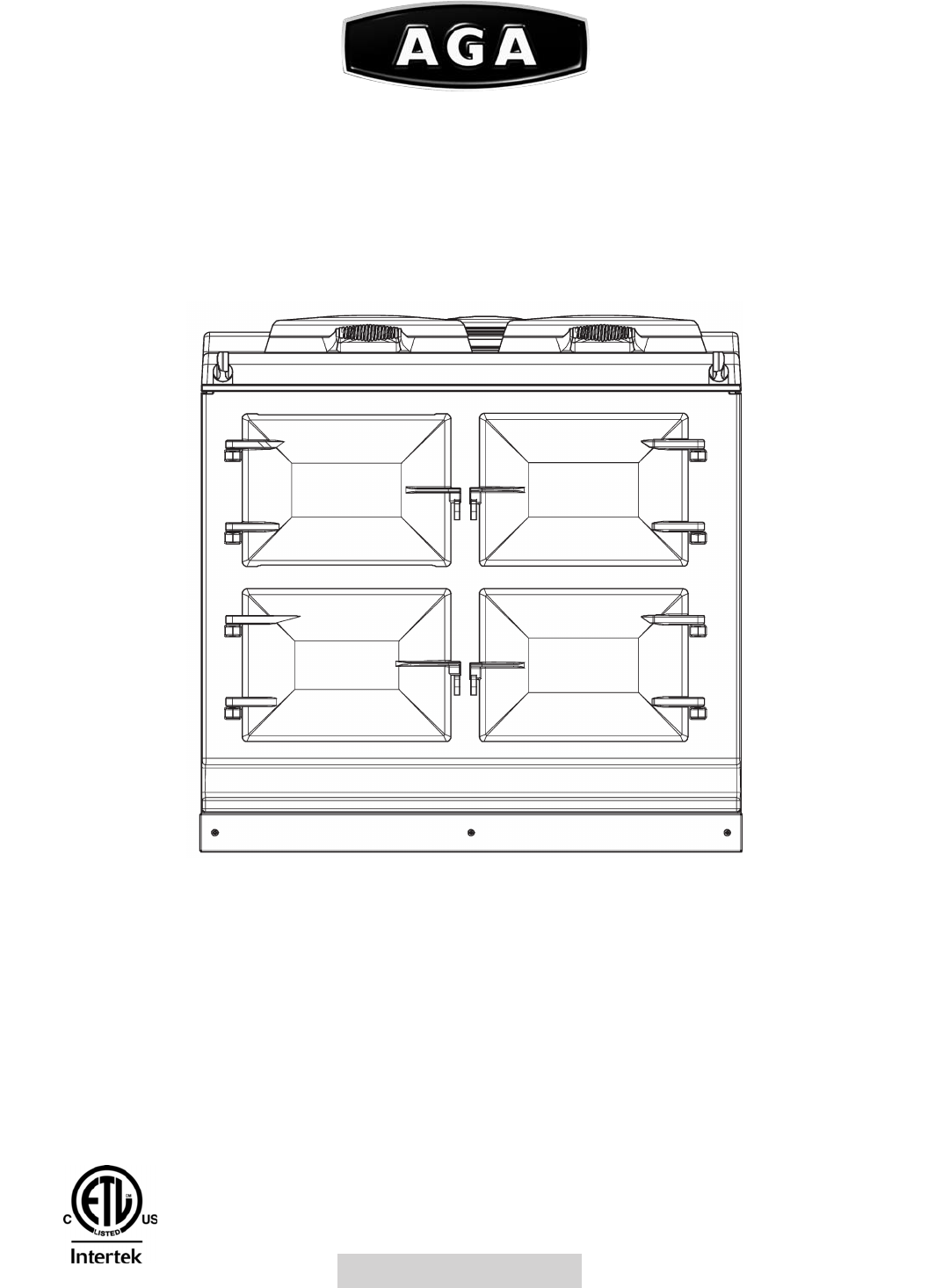
Users
Instruction
11/12 EOPI 516292
PLEASE READ THESE INSTRUCTIONS BEFORE USING THIS APPLIANCE
IMPORTANT : SAVE INSTRUCTIONS FOR THE LOCAL INSPECTORS USE
CUSTOMER: KEEP THESE INSTRUCTIONS FOR FUTURE REFERENCE
REMEMBER: when replacing a part on this appliance, use only replacement parts
that you can be assured conform to the safety and performance specification that
we require. Do not use reconditioned or copy parts that have not been clearly
authorized by AGA.
For use in USA/Canada
AGA TOTAL CONTROL
Model No. - TC3 & TC5
3139291

3 Warnings
4 Introduction
4 A Brief Description - AGA TC3
5 A Brief Description - AGA TC5
8 How to use your AGA Total Control
9 AGA Total Control Operating Modes
10 General Advice
11 Handset
11 Handset Advice
12 Communication/Handshake
13 The Date/Time Setting Screen
14 Auto Events/Program Screen
15 Information (Home) Screen
16 Power Outages
16 Automatic Update of Time
16 Changing Batteries
17 Using the Zones of the AGA Total Control
17 The Hotplates
17 The Boiling Plate
18 The Simmering Plate
18 The Top Plate
19 The Ovens
20 The Roasting Oven
21 The Baking Oven
22 The Slow Cook Oven
23 AGA TC5 (Hotcupboard Option)
24 Cleaning and Caring
25 Fitting of Oven Shelves
25 Removal of Oven Shelves
25 Fitting and Removal of Oven Doors
26 Service
26 Warranty
28 Error Codes
28 Serial Number
28 Health and Safety
29 AGA Basic Recipes
CONTENTS
2

WARNINGS
3
INCORRECT USE OF THIS RANGE CAN INCREASE THE RISK OF FIRE, ELECTRIC SHOCKS OR INJURY TO
PERSONS. PLEASE READ THE FOLLOWING PRECAUTIONS TO REDUCE THESE RISKS.
Be sure your appliance is properly installed and grounded by a qualified technician.
Never use your appliance for warming or heating the room.
USER SERVICING
Do not repair or replace any part of the appliance unless specifically recommended in this manual. All other servicing
should be referred to a qualified technician.
VENTILATING HOODS (WHERE APPLICABLE)
• Clean ventilating hoods frequently, grease should not be allowed to accumulate on the hood or filter.
• When flaming foods under the hood, turn the fan on.
BASIC RANGE SAFETY PRECAUTIONS
• Materials such as gasoline, vapors and liquids which can catch fire and explode must not be stored in, above or near
a range.
• Make sure that nothing is allowed to prevent the flow of air to the electric control compartment.
• Ensure space storage cabinets are capable of supporting the heavy weight of cooking utensils of the range.
• The maximum depth of any cabinets installed above the top of the range must not exceed 330mm (13in)
CHILD SAFETY
Children are more sensitive to heat than adults, therefore they MUST be made aware of the following safety precautions.
1. Do not leave children alone or unsupervised near the range and discourage them from this area.
2. Children should not be allowed to mount any part of the range.
3. Children MUST be taught that the range and its utensils can be hot.
4. Children should be taught that the range is not a toy. They should be forbidden to play with the range electric controls
behind the outer burner door or any other range parts.
5. Let the heavy, hot utensils cool in a safe place but of out reach of small children.
CAUTION: AVOID STORING ITEMS OF INTEREST TO CHILDREN IN ANY CABINETS INSTALLED ABOVE THE
RANGE TO PREVENT IT BEING USED TO OBTAIN ACCESS AND POSSIBLE SERIOUS INJURY.
DO NOT TOUCH SURFACE UNITS OR AREAS NEAR UNITS - SURFACES MAY BE HOT. Areas near surface units may
become hot enough to cause burns, do not touch, or let clothing or other flammable materials contact surface units or
areas near units.
GREASE
WARNING:HOT GREASE IS FLAMMABLE. Wipe off any grease deposits on the range top and front. Do not leave
containers of cooking fat around the range. In the event of a grease fire, do not remove the pan, cover the pan to extinguish
the flame.
WARNING: DO NOT USE WATER ON GREASE FIRES - Smother the fire or flame or use dry chemical or
foam-type extinguisher.
RANGE COOKING SAFETY PRECAUTIONS AND HINTS
Never reach directly into a hot oven to add or remove cooking utensils. Instead pull the grid shelf out of its maximum
projection and load or remove utensils. Oven gloves will be necessary on utensils removal.
WEAR PROPER APPAREL - Loose fitting or hanging garments should never be worn whilst using the appliance.
STORAGE IN OR ON AN APPLIANCE - Flammable materials should not be stored in an oven or near surface units.
NEVER LEAVE BOILING PANS UNATTENDED - Boilover causes smoking and greasy spillovers may ignite.
GLAZED COOKING UTENSILS - Only certain types of glass, glass/ceramic, ceramic, earthenware, or other glazed utensils
are suitable for range-top service without breaking due to the sudden change in temperature.
UTENSIL HANDLES SHOULD BE TURNED INWARD AND NOT EXTEND OVER ADJACENT SURFACE UNITS - To reduce
risk of burns, ignition of flammable materials, and spillage due to unintentional contact with the utensil, the handle of a
utensil should be positioned so that it is turned inward, and does not extend over adjacent surface units.
USE CARE WHEN OPENING OVEN DOOR - Let hot air or steam escape before removing or replacing food.
DO NOT HEAT UNOPENED FOOD CONTAINERS - Build-up of pressure may cause container to burst and result in injury.
KEEP OVEN VENTS DUCTS UNOBSTRUCTED.
USE ONLY DRY POTHOLDERS - Moist or damp potholders on hot surfaces may result in burns from steam. Do not let
the potholder touch hot heating elements. Do not use a towel or other bulky cloth.
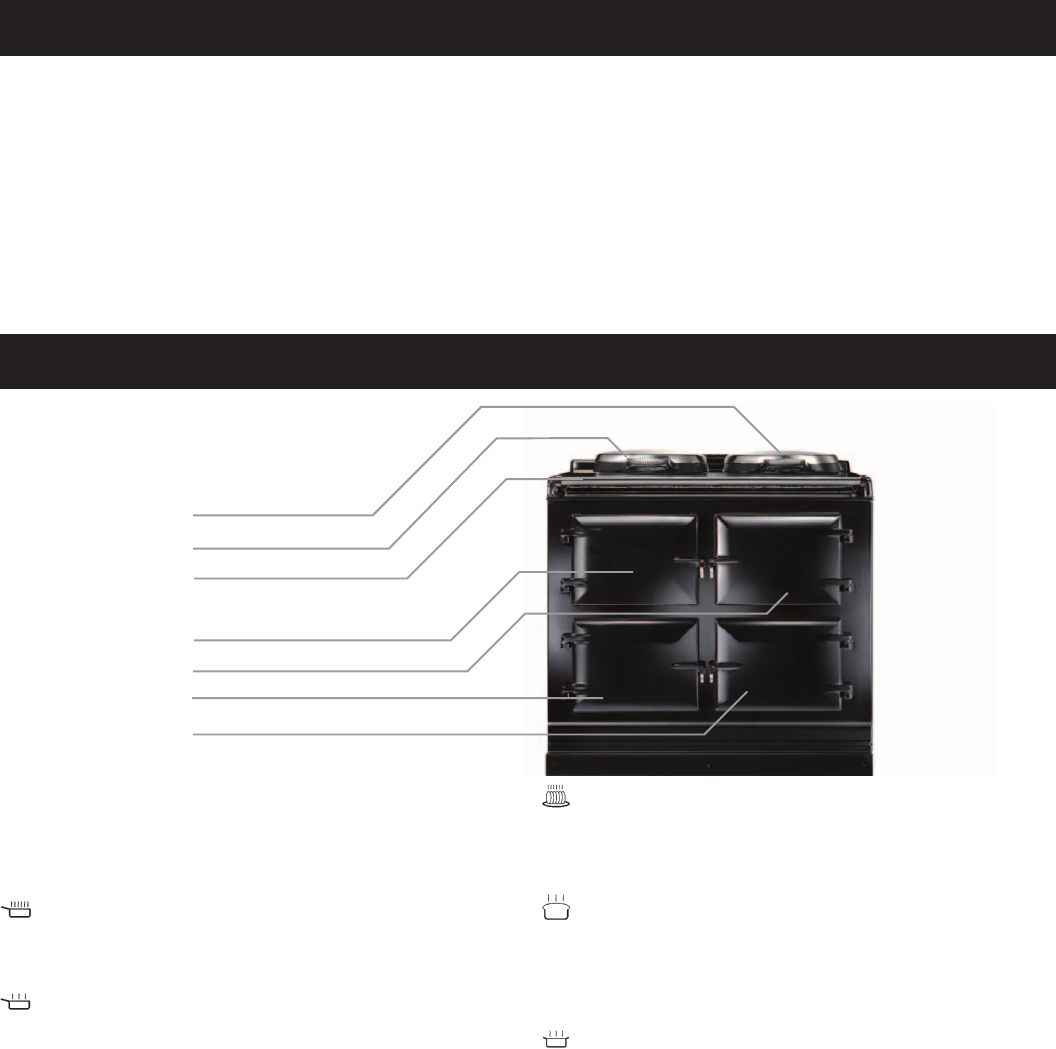
INTRODUCTION
Your new AGA Total Control gives you everything you love about the classic AGA heat storage cooker, but with the added convenience of
touchscreen technology and the ability to turn each cooking area on and off, as and when you want it.
Made in the heart of Shropshire, your AGA cooker, like the generations of cookers before it, has been manufactured from cast iron at the
Coalbrookdale Foundry. Traditional iron-making skills combined with industrial strength elements enable the ovens and hotplates to heat up
rapidly, so you can have them all on, or just one on, depending on the time of day or the size of your army.
The cooking excellence of the AGA cooker has been famous since it’s inception in the 1920’s, and is renowned due to the indirect radiant
heat that its cast iron emits rather than just air temperature. And, if you haven’t found out already, you’ll soon discover that food that is cooked
this way retains its natural flavour and succulence, and simply just tastes just better.
So grab a cup of tea, have a read, and prepare to dig into some of the tastiest dishes you’re ever likely to make.
Simmering plate
Boiling plate
Top plate
Control door
Roasting oven
Baking oven
Slow Cook oven
Hotplates
The two hotplates are at different heats; the boiling plate being the
hottest of the two and the simmering plate at a lower heat. Each
hotplate is individually temperature controlled.
Boiling Plate
The boiling plate is used for making toast, boiling a kettle, stir-frying
and cooking at a high heat.
Simmering Plate
The simmering plate is for cooking slower, such as sauces,
simmering pans and can also be used direct on for toasted
sandwiches, drop scones, non-fat fried eggs and quesadillas.
Roasting Oven
The hottest oven for high temperature cooking; pastries, breads,
roasting of meat, vegetables and poultry, grilling at the top of the
oven and frying on the floor.
Baking Oven
A moderate oven for cooking cakes and biscuits, baking fish,
lasagne or shepherds pie, plus roasting meat and poultry at a
medium heat. Cooking sweets and savoury together is no problem
as the flavours do not mix.
Slow Cook Oven
Long, slow cooking in the slow cook oven develops flavours and
makes the toughest meat tender. Its large capacity means several
pans can be stacked here; soup, casserole, steamed rice, steamed
carrots and poached pears all cooking simultaneously, without any
danger of burning.
A BRIEF DESCRIPTION - AGA TC3
4
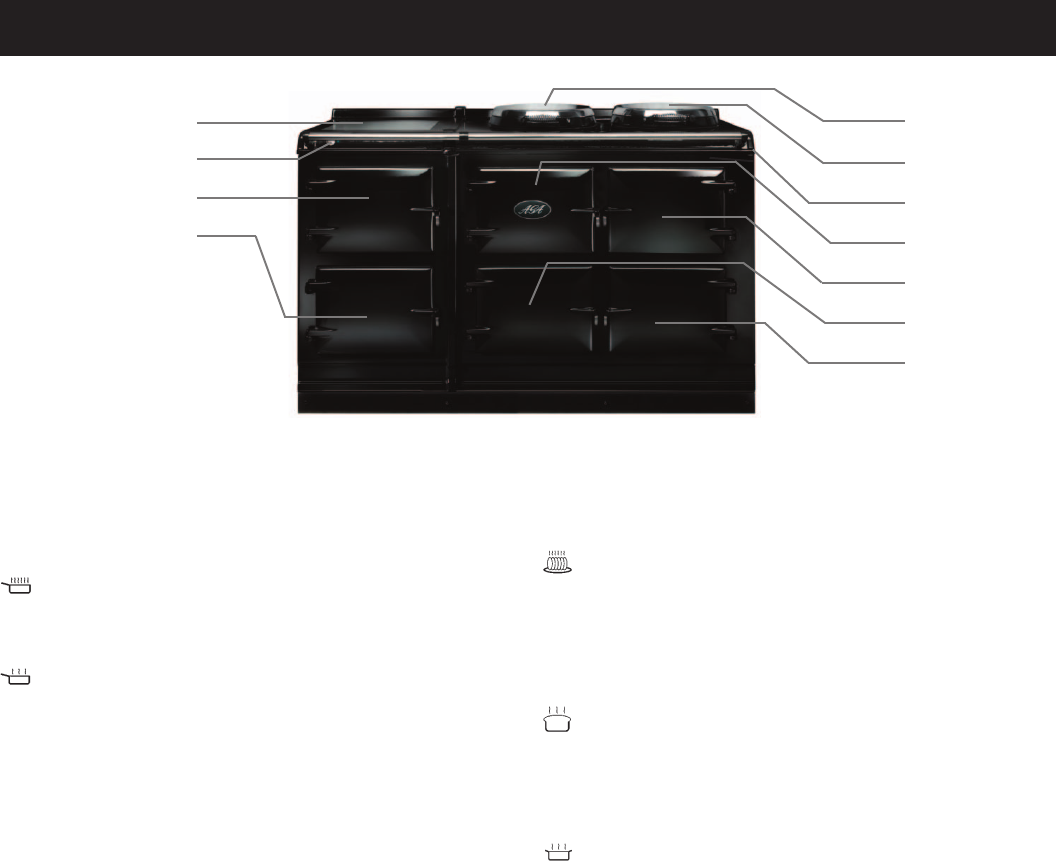
A BRIEF DESCRIPTION - AGA TC5
Warming plate
Hotcupboard ON/OFF
Slow cooking oven
Warming oven
Boiling plate
Simmering plate
Top plate
Control door
Roasting oven
Baking oven
Simmering oven
Hotplates
The two hotplates are at different heats: the boiling plate being the
hottest of the two and the simmering plate at a lower heat.
Each hotplate is individually temperature controlled.
Boiling Plate
The boiling plate is used for making toast, boiling a kettle, stir-frying
and cooking at a high heat.
Boiling Plate
The simmering plate is for cooking slower, such as sauces,
simmering pans and can also be used direct on for toasted
sandwiches, drop scones, no-fat fried eggs and quesadillas.
Warming Plate (Hotcupboard)
The warming plate is the ideal resting plate for cooked food.
Slow Cooking Oven (Hotcupboard)
Ideal for a broad range of long slow cooking applications such as leg
of lamb, pulled pork, belly pork and celebration cake.
NOTE: Meat and vegetable dishes should be started on the boiling
plate or in the roasting oven.
Warming Oven (Hotcupboard)
Used for warming plates and serving dishes. Can also be used for
resting joints before carving.
Roasting Oven
The hottest oven for high temperature cooking; pastries, breads,
roasting of meat, vegetables and poultry, grilling at the top of the
oven and frying on the floor. The oven, as the others is vented
mechanically through an external wall, so the majority of cooking
smells are taken to the outside.
Baking Oven
A moderate oven for cooking cakes and biscuits, baking fish,
lasagne or shepherds pie, plus roasting meat and poultry at a
medium heat. Cooking sweet and savoury together is no problem as
the flavours do not mix.
Simmering Oven
Long, slow cooking in the simmering oven develops flavours and
makes the toughest meat tender. Its large capacity means several
pans can be stacked here; soup, casserole, steamed rice, steamed
carrots and poached pears all cooking simultaneously, without any
danger of burning.
5
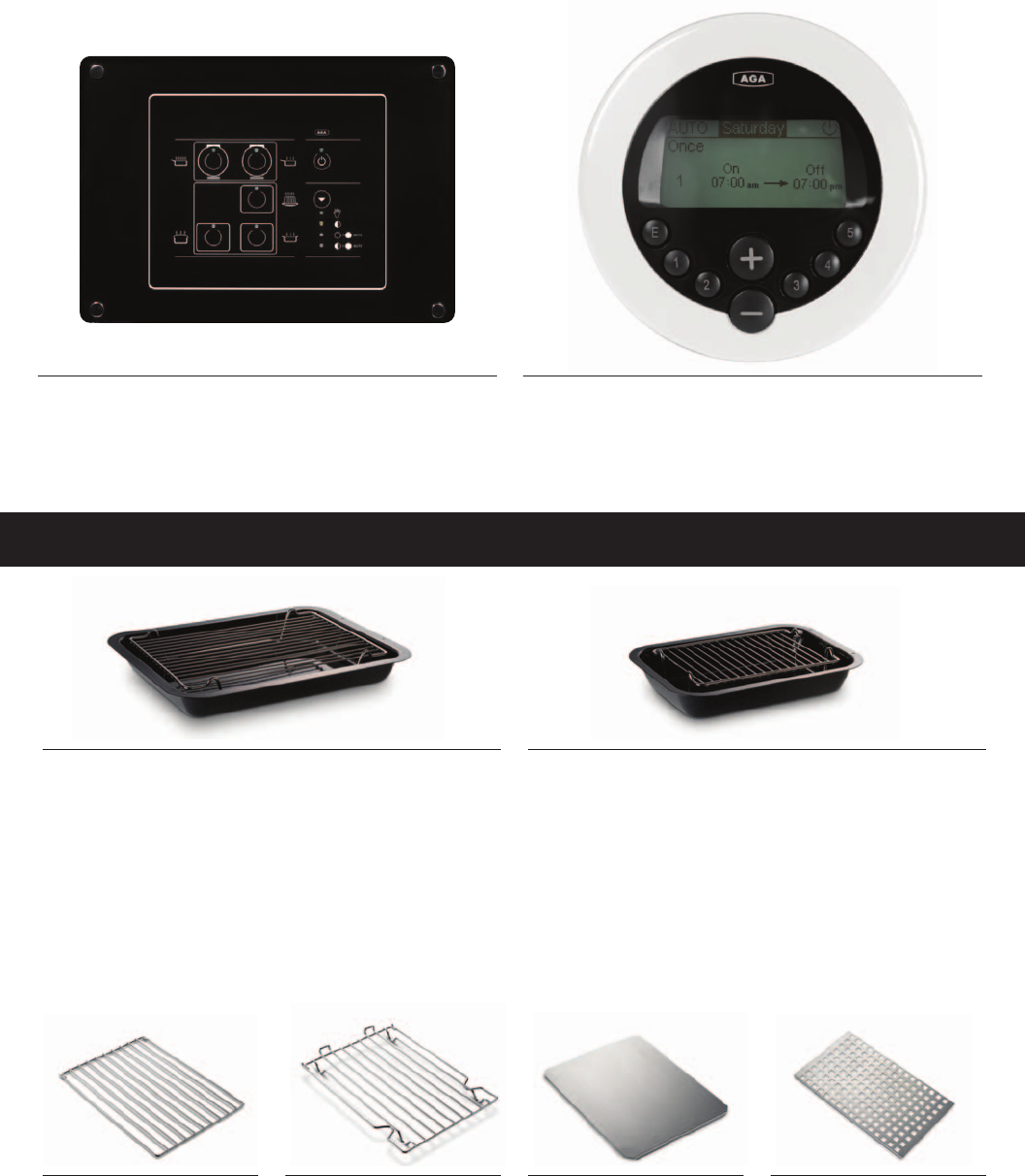
Control Panel
This is situated behind the top left hand door. The control panel
contains touch sensitive buttons with a green or orange light
(LED indicator) to indicate which zone is activated. An audible
beep will confirm selection.
Handset
Your AGA Total Control cooker also comes with a Handset
which can be used to program the ovens. It displays the time,
date and program events. The hotplates work on
Manual only.
EQUIPMENT SUPPLIED WITH YOUR AGA TOTAL CONTROL
Large Size Roasting Pan with Grill Rack
This is designed to slide onto the oven runners without the
need for it to sit on an oven grid shelf. The roasting pan can be
used with the grill rack, in its high position, for grilling at the top
of the roasting oven. It can be used for roasting meat, or
poultry with or without the grill rack. Large quantities of roast
potatoes can be cooked in this tin. The roasting pan can also
be employed for making large sponges or cakes. The grill rack
is useful on its own as a cake cooling rack. Can be used in any
oven but not recommended for hotplate use.
Half Size Roasting Pan and Grill Rack
This pan can be slid onto the oven runners width-ways or can
sit on an oven grid shelf. The half size roasting pan can be
used with the grill rack, in its high position, for grilling at the top
of the roasting oven. It can be used for roasting smaller joints
of meat, or poultry with or without the grill rack. Roast potatoes
can be cooked in this pan. The roasting pan can also be
employed for making sponges or cakes. The grill rack is
useful on its own as a cake cooling rack. Can be used in any
oven but not recommended for hotplate use.
1 Floor Grid
This grid is used on the floor
of the ovens, in particular the
roasting and simmering
ovens to protect food
needing over 30 minutes
cooking from the intensity of
the heat from the base
element.
3 Oven Grid Shelves
These are for inserting in
each oven to provide a
surface for dishes and tins
which do not fit direct onto
the oven runners. They can
be used in any oven, as
required. See page 25 on
how to locate the oven
shelves correctly.
1 Cold Plain Shelf
Known as the cold plain shelf
because it is recommended
this shelf should be kept out
of the ovens when not in use.
It has two uses one as large
baking sheet for scones,
biscuits, pastry items and
meringues and the other use
as a heat deflector to cut off
the top heat if food is
overbrowning before it is
cooked through.
Roasting Oven
Perforated Baffle
A roasting oven perforated
baffle is positioned in the top
of the roasting oven, in order
to optimise cooking
performance. For best
results, please ensure it is in
place at all times, while the
oven is in operation, including
when grilling. The Installation
Engineer will fit this in place.
This can also be removed
for cleaning.
6
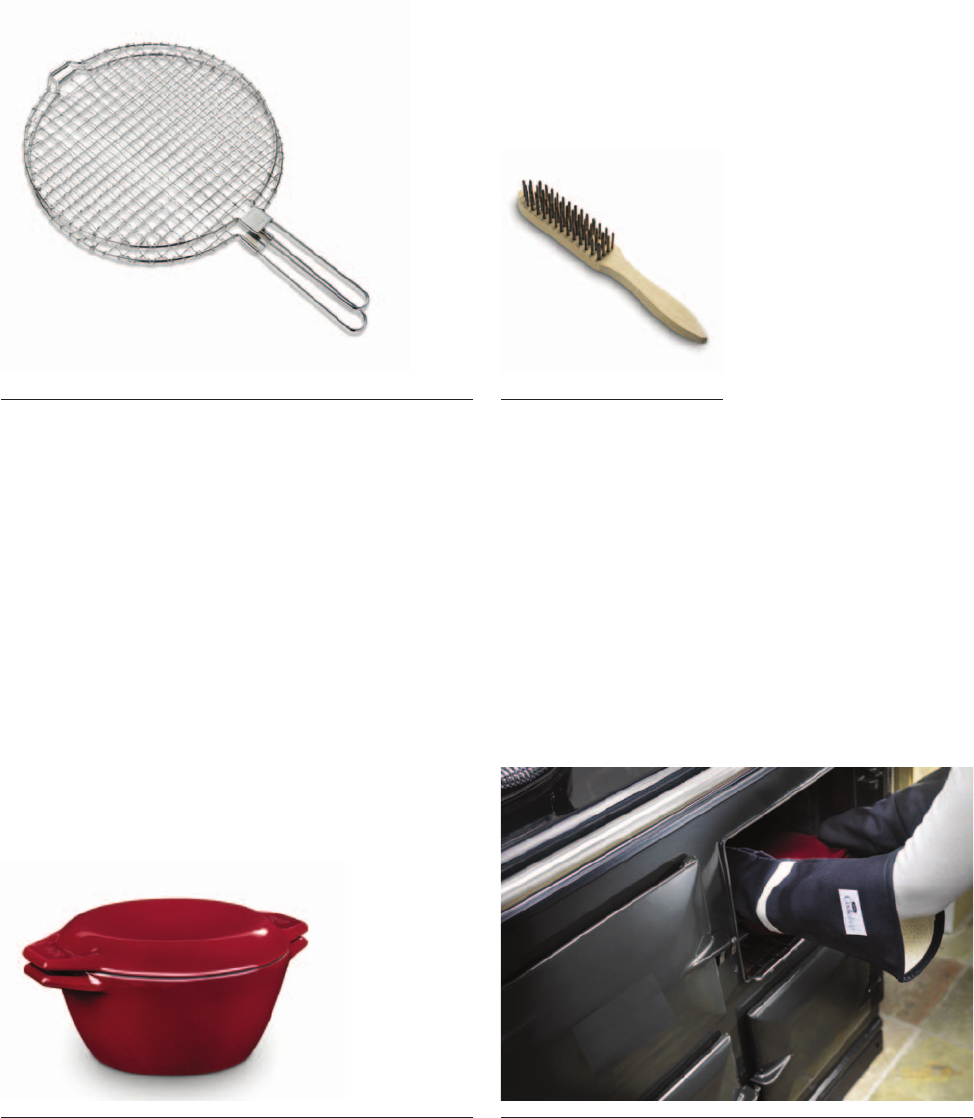
Wire Brush
This is for cleaning the raw
cast iron surfaces, keeping
them clear of crumbs and
burnt on debris – which
would otherwise affect the
boiling performance of pans
and the kettle. Use on the
hotplates and the ovens. Take
care not to touch the enamel
surfaces as the wire brush will
scratch the finish.
Toaster
This is for toasting bread on the boiling plate. AGA toast is
renowned for its excellence, crisp on the outside and soft in
the center. Take thick slices of bread and place in the AGA
toaster - if the bread is very moist or very fresh, heat the
toaster beforehand to prevent sticking - lift the boiling plate
insulated cover and place the toaster direct onto the plate with
the handle at an angle from the handle of the cover.
Close the cover and wait for the bread to toast one side - this
will take 1-2 minutes dependent upon the variety of bread -
open the cover and turn the toaster over and repeat the
process to toast the other side. The toaster can also be used
for heating pita bread, toasting teacakes and as a cake
cooling rack.
AGA Utensils and Accessories
To get the very best performance from your cooker we
recommend AGA saucepans with the thick tri-core bases and
stacking lids so that the maximum use of oven space is made
and an AGA kettle for boiling water. AGA Accessories can be
viewed at your AGA retailer or on agamarvel.com.
Getting to know your AGA
If you have not already seen a demonstration, ask your AGA
Specialist for details. A demonstration will show you how to get
the best from your new AGA and will give you hints and tips.
You will also see a selection of AGA utensils and accessories
being used.
7
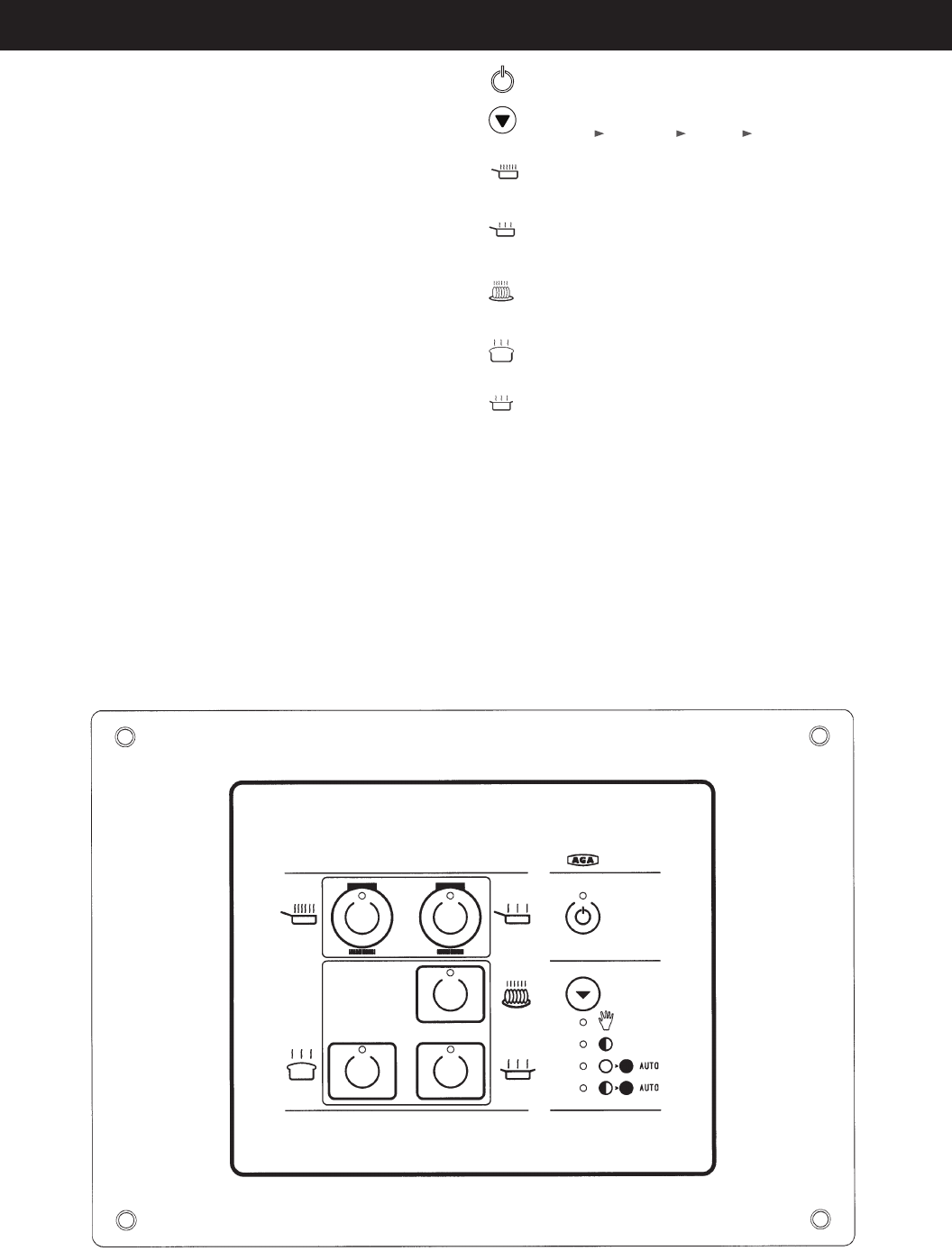
Getting started
When switching on the AGA cooker for the first few times,
there are two things you may notice, neither of which should cause
concern.
The AGA cooker will emit an odor for a short while, this is simply
due to the protective oil we put on the hotplates and ovens
burning off. Due to the newness in the first couple of hours, it is
advisable to open the kitchen window while this takes place.
Condensation may occur on the top and front plate whilst the AGA
cooker is heating up, caused by the internal insulation drying out.
The condensation should be wiped away as soon as possible to
prevent staining the enamel.
Your AGA Total Control has the external appearance of a classic AGA
heat storage enamelled cast iron cooker. However its flexibility is
almost unbounded because in place of a single heat source each
cooking zone has its own electrically heated cast iron element(s). The
separation of cooking zones, allows a choice of control. You are able
to select only those zones that you want, or need, to use.
The control panel is situated behind the top left hand door. It
contains touch sensitive buttons with a green or orange light (LED
indicator) to indicate which zone is activated. An audible beep will
confirm selection. There are eight buttons:
Standby/ON
Mode
Manual Slumber AUTO AUTO/Slumber selection
Boil (Boiling plate)
ON/OFF
Simmer (Simmering plate)
ON/OFF
Roast (Roasting oven)
ON/OFF or selected for AUTO or AUTO/Slumber
Bake (Baking oven)
ON/OFF or selected for AUTO or AUTO/Slumber
Simmer (Slow cook oven)
ON/OFF or selected for AUTO or AUTO/Slumber
HOW TO USE YOUR AGA TOTAL CONTROL
8

AGA TOTAL CONTROL OPERATING MODES
The appliance has 4 operating modes:
Mode Selection Button
Manual Slumber AUTO AUTO/Slumber
selection can only be made when standby button is on.
Standby Button
This button must be on i.e. green to operate any part of your AGA
Total Control, or for any Timed events.
Manual simply select what you require
Each heat zone (an oven or a hotplate) can be turned on or off as
required, just press the appropriate button, a green light will show
when a specific zone is in operation.
The green indicator light of the selected zone (s) will flash slowly
indicating that the zone (s) is warming up. Once the selected
zone (s)
is at temperature and ready to use the green light will stop
flashing. It is normal for the green light to flash slowly during
cooking, this indicates that the heat zone is requesting power. While
in Manual mode any zone selected will remain on indefinitely until
switched off.
Slumber (ovens only)
In this mode, all three ovens are active, (the roasting and baking
oven are pre-set to approximately 248°F, the slow cook oven is
pre-set to approximately 212°F).
When selected, the orange indicator light of the ovens will flash
slowly, indicating that the ovens are warming up, when ‘Slumber’
temperature is reached the orange light will stop flashing.
No individual oven can be ‘OFF’. However any oven can be switched
from ‘Slumber’ to full heat by one press of its button. When pressed
once, the selected oven goes to ‘full heat’, there will be a flashing
green light, when at temperature the light will stop flashing.
Pressing an individual oven button once more returns that oven back
to ‘Slumber’.
AUTO (ovens only) - brings selected ovens up to full
heat from OFF
The ovens can be selected to operate once or twice each day.
Each operation is termed an ‘event’, the start and finish time is
chosen by you unless you use the pre-set time.
The handset will have been set up by the installer. It should have the
correct time of day set. Unless you have set your own Auto
program, it will include the pre-set time (1 Event 7am - 7pm).
See Page 14 to set your own Auto program preferences.
Select ‘AUTO’ mode.
Select oven (s) for automatic operation, by pressing the appropriate
button (s).
The oven (s) selected is indicated by an orange light (unless you
have selected ‘AUTO’ during an ‘event’ period). During an ‘event’
period the light will be green.
The oven light will flash green while the oven is heating. When at
temperature the green light will stop flashing.
PLEASE NOTE:
• Don’t forget to include time for warm-up.
• Don’t forget if you have set the AUTO program and have
selected the AUTO mode, an oven or ovens must be selected
.
• The hotplates can only be operated manually.
• The last ‘AUTO’ oven selection is remembered and re-called
when ‘AUTO’ is next selected.
• DO NOT OPERATE WITH THE APPLIANCE DOORS
OPEN
9

AUTO/Slumber (ovens only) - brings selected ovens
up to full heat from Slumber.
The ovens can be selected to operate once or twice each day.
Each operation is termed an ‘event’, the start and finish time is
chosen by you unless you use the pre-set time.
See Page 14 to set your own Auto program preferences.
Select ‘AUTO/Slumber’.
Select oven (s) for automatic operation, by pressing the appropriate
buttons.
The oven (s) selected is indicated by an orange light (unless you
have selected ‘AUTO/Slumber’ during an ‘event’ period). During an
‘event’ period the light will be green.
The oven (s) selected is indicated by an orange light, the oven light
will flash orange until ‘Slumber’ temperature has been reached.
The oven light will flash green while the oven is heating from
‘Slumber’ to full temperature during its Auto/Slumber event period.
When at full temperature the green light will stop flashing.
PLEASE NOTE:-
• Don’t forget to include time for warm-up.
• Don’t forget if you have set the AUTO/Slumber program and
have selected the AUTO/Slumber mode, an oven or ovens must
be selected .
• The hotplates can only be operated manually.
• All the selected ovens will remain at ‘Slumber’ between ‘events’.
• The last ‘AUTO/Slumber’ oven selection is remembered and
re-called when ‘AUTO’ is next selected.
• DO NOT OPERATE WITH THE APPLIANCE DOORS
OPEN
AUTO and AUTO/Slumber
Changing between any of the four operating modes, will cause the
hotplates to switch OFF if in use - this is a built-in safety factor. They
can be switched back on after the mode change if required.
GENERAL ADVICE
Food SHOULD NOT be placed into any oven until it is up to normal
operating heat i.e. the green light of the selected oven is solid and
not flashing.
The oven doors should not be left open for long periods of time
during cooking and heating up.
Store the cold plain shelf outside the cooker. Use it cold in the
roasting oven to deflect heat from the top of the oven, creating a
more moderate oven temperature underneath. It can also be used as
a baking sheet.
When an oven or hotplate is at temperature, and is then loaded with
food or cold pans/trays, the zone light may flash as the oven and/or
hotplate calls for extra heat.
Warm up times
When a zone is heating up it will be indicated by a flashing green or
orange light on the control panel. When a zone has reached
temperature a solid green or orange light will indicate it has warmed
up, AGA recommends that for full heat to saturate the castings it is
best to leave them for one hour for the optimum cooking results.
Boiling Plate
The boiling plate takes approximately 11 minutes to reach
temperature from cold.
Simmering Plate
The simmering plate takes approximately 8 minutes to reach
temperature from cold.
Roasting Oven
The roasting oven takes approximately 35 minutes to reach
temperature from cold, and approximately 15 minutes to reach
temperature from ‘Slumber’.
Baking Oven
The baking oven takes approximately 22 minutes to reach
temperature from cold, and approximately 15 minutes to reach
temperature from ‘Slumber’.
Slow Cook Oven
The slow cook oven takes approximately 45 minutes to reach
temperature from cold.
PLEASE NOTE: For optimum cooking performance, after the
temperature has been reached, we recommend leaving for another
30 minutes for the castings to become heat saturated, particularly
relevant if you are cooking a large meal or baking.
PLEASE NOTE: The times are based on each zone being
operated individually. If a large combination of zones are turned on
simultaneously, it may slow down the individual warm up times. If all
zones are turned on at the same time it will take approximately one
hour for the whole appliance to reach operating temperature.
These times are based on the cooker having a single phase supply of
32 amps @ 230 V. For other power supply configurations, these
times may change.
10
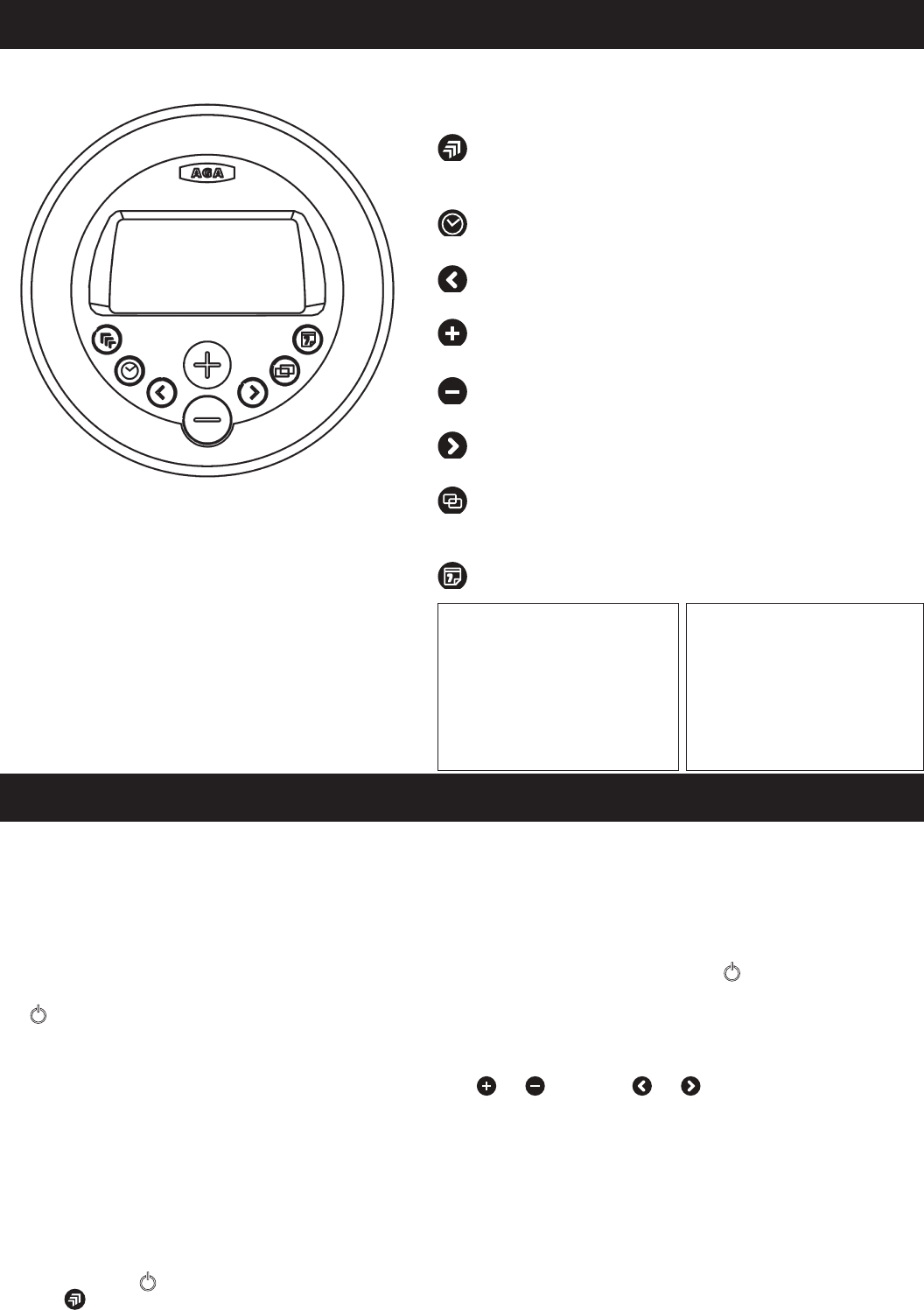
Button Operations
1. Communication or ‘Handshake’ button
used initially to synchronise the handset to the AGA Total
Control. (On day of installation or in case of replacement handset
2. Clock button
Opens and closes the date and time settings screen.
3. Left/Back Button
Moves back and highlights the previous setting.
4. Plus Button
Increases the highlighted setting.
5. Minus Button
Decreases the highlighted setting.
6. Right/Forward Button
Moves forward and highlights the next setting.
7. Copy Button
copies the time program from the current day to the
following day in the 7-day event calendar screen.
8. 7-day event Button
Opens and closes the 7-day event calendar screen.
HANDSET - A HAND HELD CONTROL
Screens
The handset has 3 main screens.
1. The Information Home screen (main menu)
2. The Date/Time screen
3. The Events Programming screen
The display will revert to ‘sleep’ mode after approximately 3
minutes. Simply press the required button to open up any
screen.
The handset displays the time, date and events. Programming is via eight push buttons. The information is displayed via a back-lit LCD
screen.
HANDSET ADVICE
Operating Distance
The handset will only operate in the same room as the cooker and up
to a maximum distance of 13 feet (4 metres) from the appliance. If
out of recommended operating range, the handset may show
‘Standby’. If this happens move the handset back to within the
recommended distance and it should correct itself, see below.
Handset to AGA Total Control Signal Check
The (Standby) symbol is shown when in the following situations:-
1. In Standby mode
2. If communications fail
3. There is a power cut
4. If the handset is out of range of the AGA Total Control cooker
When transferring information from or to the controller always
operate the handset in front of the cooker, this gives the strongest
signal.
If the handset shows Standby, when the cooker is on,
press the button firmly for 1 second, this will activate
the communication link between the cooker and handset.
Communication/Handshake
For details on initial Communication/Handshake, see Page 12.
Preview Mode
If the handset is out of range of the cooker or if the appliance is
switched off, Preview only mode is available. Changes cannot be
made to the programmed events. The symbol is
displayed in the screen and the message ‘Preview only’ is
displayed briefly when the events program screen is first
entered.
When in Preview Mode you can review the days by using the
and buttons. The and buttons become inactive and you
cannot make any changes.
Handset Failure
In the unlikely event of handset failure, the appliance would still
be operational with the last selected program. The cooker
can also be changed to Manual mode from one of the auto modes
using the mode button on the control panel. If the handset is
damaged or lost, a replacement can be obtained from AGA and
re-programmed to suit your appliance.
DO NOT PLACE THE HANDSET ON ANY HOT
SURFACES.
11
USA
Model Number AGA TC3
FCC ID: A2M-AGA-TC3
FCC ID: A2M-AGA-TC3CKR
This device complies with part 15 of the FCC
Rules. Operation is subject to the following
two conditions: (1) This device may not
cause harmful interference, and (2) this
device must accept any interference
received, including interference that may
cause undesired operation.
CANADA
Model Number AGA TC3
IC: 10181A-AGATC3CKR
Model Number AE4M280526
IC: 10181A-AGATC3
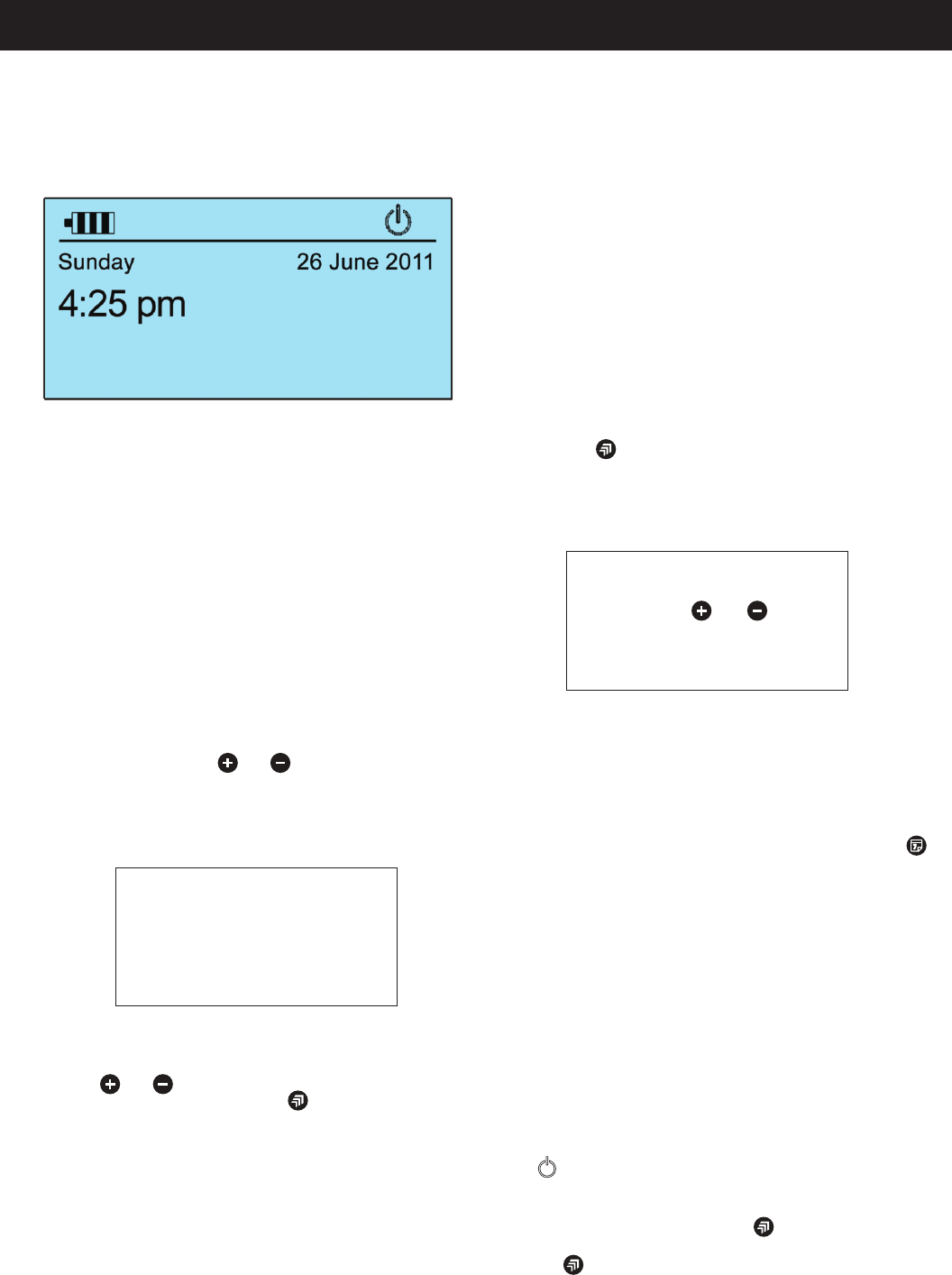
Notes
• symbol appears in the top right hand corner of the screen,
if the handset is out of range with the cooker or the
communication/handshake process has not been completed.
When communication is OK then symbol is displayed.
• The button can be used to force communication between
the cooker and the handset. This function is active
once successful initial communication has been made, and
the handset is in range.
This process will be required on the original installation of the AGA Total Control. If the handset is replaced for any reason the new handset
will need to be synchronised.
• You will also need to set the time and date.
• You will also be given the option to set your own Auto program preferences.
Step 1
Handshake can be activated 30 seconds after main power
has been applied to the cooker. The Standby
button on the touch panel must be ‘ON’. It must then be
completed within 2 minutes, otherwise you will need to
repeat the process.
Step 2
Press and hold button on the handset for 10 seconds
to open the communicate/synchronise screen.
The following screen message then appears.
Press and
to synchronise
COMMUNICATION/HANDSHAKE
Step 3
Simultaneously press the and buttons, the serial
number will be ‘found’ by the handset.
The following screen message then appears briefly.
Step 4
Use the and buttons to choose the language you want
the handset text to be in, then press to confirm the
language choice required.
Once time and date has been set the Auto/Event program
screen will appear.
Step 5
Set the correct time and date see Page 13.
Step 6
You have the option to set your own Auto program at this
stage, see Page 13. If you wish to leave until later, then press
it will remain at the pre-set times: 1 Event 7am - 7pm (7 days).
Serial Number
found
12
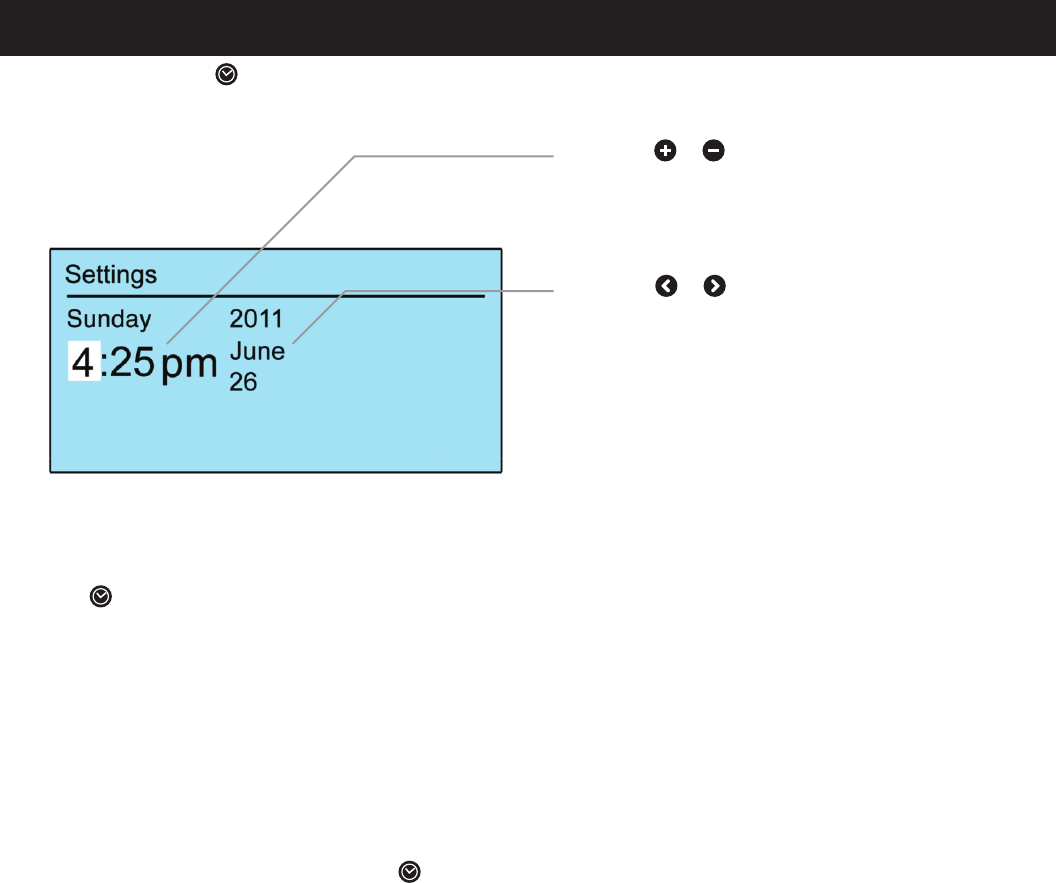
THE DATE/TIME SETTING SCREEN
Press and hold Clock button until the screen is displayed.
In this screen the time, date, month and year can be altered/set.
Press the or buttons to alter the highlighted time,
date, month and year settings.
Press the or buttons to cycle between the time,
date, month and year.
Press button at any stage to save the settings and exit the
DATE/TIME screen.
‘Message sent OK’will appear on the screen when the handset
is in range of the cooker.
‘Changes stored on handset only’will appear on the screen,
when the controller handset is out of range of the cooker.
Notes
• Even if no changes are made to the time, date, month
and year settings, a press of the clock button is still
required, to return to the Home screen.
• The day cannot be changed as the handset automatically
knows this information, when the date and year is set.
• The Home screen will automatically appear after the
replacement of new batteries.
13
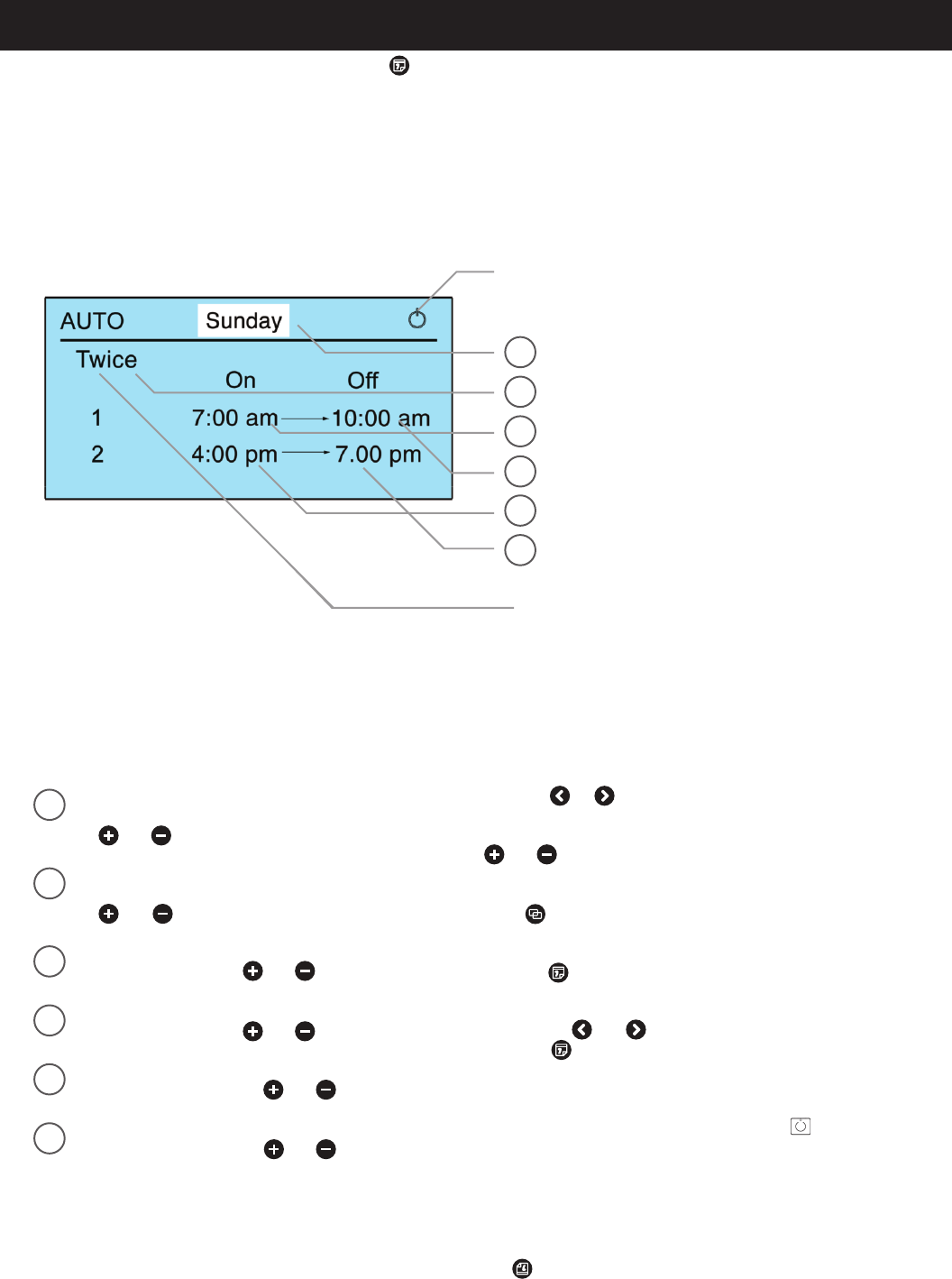
AUTO/EVENTS PROGRAM SCREEN
Stand-by icon will appear if in Preview Mode.
‘Twice’ will be shown if two events are set.
‘Once’ will be shown if one event is set.
‘No’ will be shown if no events are set.
1
2
3
4
5
6
This screen is opened by pressing the 7-day event button .
In this screen, the number of events and the start and end time of events can be set. Each day can have a different number of events, and
start and end times, or all seven days can be the same.
There are pre-set times already programmed, to change to your desired settings follow these instructions. Pre-set times are 1 event 7am -
7pm (7 days).
What you can do
1 The current day is shown on the display, this can be
changed to the day that you wish to edit by pressing
the and buttons.
2 This shows the number of events in that day.
This can be changed from no, once or twice by pressing
the and buttons.
3 This shows the start time of the first event. This can be
changed by pressing the and buttons.
4 This shows the end time of the first event. This can be
changed by pressing the and buttons.
5 This shows the start time of the second event. This can
be changed by pressing the and buttons.
6 This shows the end time of the second event. This can
be changed by pressing the and buttons.
How you do it
Press the or buttons to navigate through the
settings on the screen. When a setting is selected
it will be highlighted by a dark box. Pressing the
and buttons. will change the information in
this highlighted box.
Press to copy program settings to next day.
If you have made changes and wish to exit this screen,
press the button. A ‘Save Changes’ - Yes or No?
message will appear on the screen.
Pressing the and buttons will highlight Yes or No.
Press the button again to confirm your choice.
REMEMBER: After setting the Auto event that an oven
selection must be chosen on the touch panel if you wish to
activate the program you have just entered.
Notes
• Even if no changes are made a press of the
button is still required, to return to the Home screen.
14
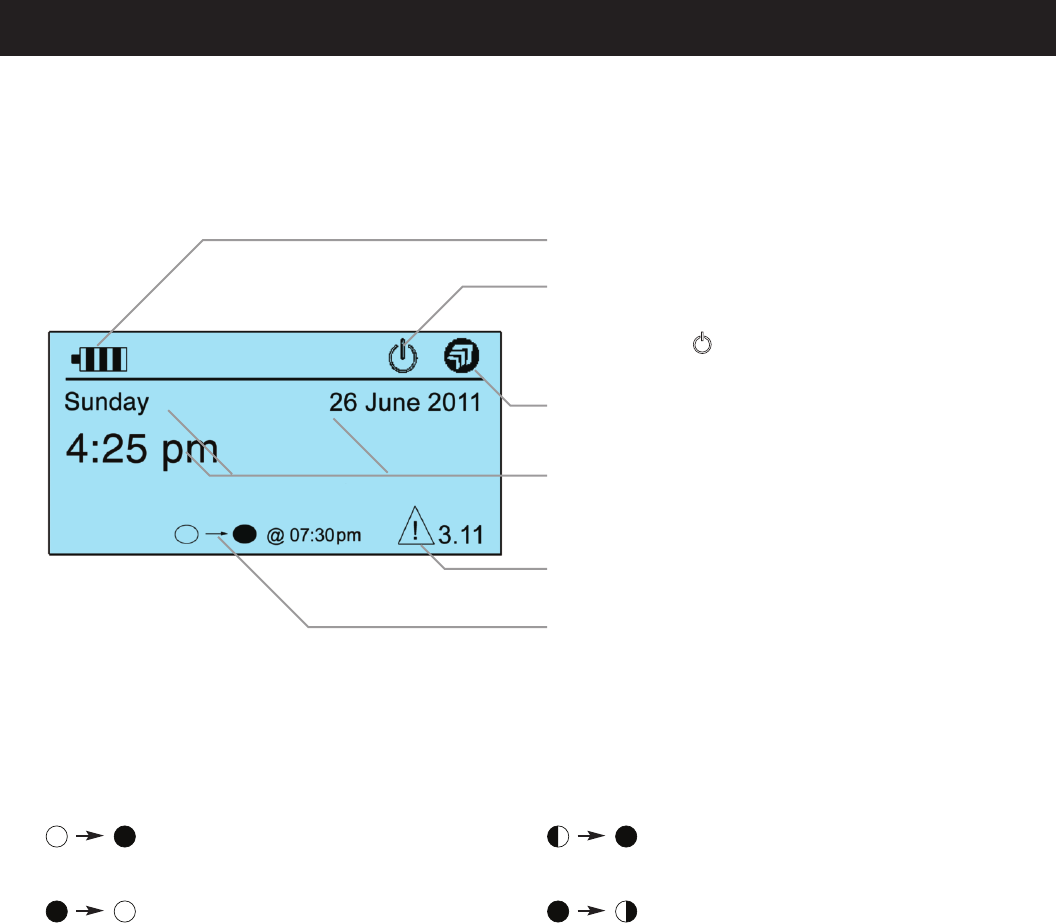
INFORMATION (HOME) SCREEN
If there is no communication between the AGA Total
Control and the handset because: the cooker is not
powered, in standby or the handset is out of range from
the cooker. The symbol is displayed.
This is the main screen, where information such as time, date, battery life and connectivity is displayed. If you have programmed either of the
‘AUTO’ modes and they are currently in progress, the next change of event will also be displayed. The information below explains this in more
detail.
Press any button on the handset to open this screen, from ‘Sleep’ mode.
Symbol indicating the battery life.
Symbols indicating the current time and day.
Change of Event Symbols
AUTO event on
(before AUTO event)
AUTO event OFF
(during AUTO event)
AUTO/Slumber event ON
(before AUTO/Slumber event)
AUTO/Slumber event OFF
(during AUTO/Slumber event)
Communication/Handshake symbol indicates
communication between the cooker and handset
is OK.
Warning triangle and error code is displayed if
an error occurs.
If either AUTO or AUTO/Slumber mode is active the
next event change will be displayed for that day with
the relevant symbols to show start and end times.
NOTE: If standby icon is shown then event indicator
will not be displayed.
15

Power Outages under 10 minutes
When the power is restored, the AGA Total Control will resume
normal operation as was set prior to the power interruption.
Power Outages over 10 minutes
Most functions will have turned OFF.
• ‘Manual’ mode - all zones OFF.
• ‘Slumber’ mode - hotplates OFF, Slumber ON
• ‘AUTO’ mode - hotplates OFF, ovens continue with the set
programme.
• ‘AUTO/Slumber’ - hotplates OFF, ovens continue with the
set programme.
A ‘Power Outage’ message may appear on the handset screen,
confirm by pressing any button on the handset. Therefore the cooker
may not be at temperature when expected.
Automatic Update of Time
In the event of power cuts the handset will automatically update the
controls within the cooker to the correct time on restoration of power. This
is provided that the following criteria are met:
1. The handset is sited within range of the cooker
2. The handset has good batteries
3. The handset contains the correct time itself
Batteries
The handset is fitted with four ‘AAA’ batteries, which are packed
separately. Your installer will insert them when your AGA Total
Control cooker is installed. When replacing the batteries, follow
these instructions inconjunction with the diagrams.
Remove the handset from its backplate, then remove the battery
cover plate from the rear of the handset (Fig. 1). Carefully lever out
the batteries commencing with the bottom one first pushing and
pulling out on the positive (+) end only (Fig. 2). Repeat this procedure
to remove the other batteries.
Always use long life batteries for replacements - rechargeable
batteries are not recommended.
Replace the batteries commencing with the bottom one working to
the top (Fig. 3).
Battery life will depend on usage. Replace the batteries when the
battery symbol on the handset is down to one bar.
Care and Cleaning
The handset should be wiped clean using a soft clean cloth.
Do not use abrasive cleaning products or submerge the handset in
water.
fig 1 fig 2 fig 3
16

USING THE ZONES OF THE AGA TOTAL CONTROL
The different zones of the AGA Total Control cooker are described in
the following pages individually. Recipe suggestions are given for
each area or zone with alternative cooking methods - the choice is
yours whichever is most convenient to you. For instance you may
prefer to use just the hotplates for a quick dinner in the week or there
can be a choice of an oven alternative when you have the ovens on
during the colder weather or at weekends, when you are doing more
cooking.
The classic AGA heat storage cooker is famous for the gentle warmth
it emits, with the AGA Total Control you will get warmth only when
the cooker is on or warmth to a lesser degree when only parts of it
are on.
The hotplates are operated manually, make sure the standby button
is on then just press the touch control panel of the hotplate you need
and a flashing green light will appear, when the hotplate reaches its
full preset heat it will become solid green.
The boiling plate is on the left hand side and the simmering plate is
on the right hand side of the AGA Total Control. The boiling plate is
the hottest with the simmering plate being the cooler of the two.
They both have electric elements embedded into the cast iron which
heat up in approximately 11 and 8 minutes respectively. The
hotplates can be used completely independently from the ovens.
This means the AGA Total Control differs from the classic AGA heat
storage cooker in that they can be used for the entire cooking time of
appropriate dishes because the design keeps the hotplates at a
constant heat, whereas the classic AGA cooker continues to cook on
a falling heat so for these we recommend starting on the hotplate(s)
then transferring to the ovens, this can be done with the AGA Total
Control but is not necessary. For instance, if making a pasta dish
with sauce on the AGA Total Control, it can all be done on the
hotplates.
The whole hotplate area can be used for cooking and several pans
can be accommodated on a single plate at any one time. The
hotplates are set very slightly above the top plate to avoid accidental
scratching if the pans are pulled to one side. Do not drag the utensils
from one plate to another as the enamel will suffer!
The stainless steel insulated covers are brought down over the
hotplates when they are not in use. When the hotplates are ‘on’ the
insulated covers will be warm. We strongly advise not to put anything
such as kettles, saucepans or baking tins directly onto the insulated
covers because they will show any scratches – invest in a pair of
chef’s pads to protect the surface if the covers are to be used as
resting places!
Keep the hotplates clear of any burnt on food or crumbs by brushing
with the wire brush, supplied with your AGA. Cleaning details can be
found on page 24.
THE HOTPLATES
THE BOILING PLATE
The hottest hotplate, the boiling plate is used for boiling, grilling,
stir-frying, making toast - indeed anything that requires a high heat.
Green vegetables keep their colour when boiled quickly here, or use
a steamer over the saucepan to cook more than one vegetable at
once.
When stir frying or cooking anything that is inclined to splash we
would recommend using an AGA Splash Shield which will protect the
insulated cover from splatter, making cleaning simple and easy! Just
wash the Splash Shield in hot soapy water or place in a dishwasher
between two dinner plates.
Please be advised the boiling plate is too hot to cook food direct on
it.
For recipes ideas , see separate recipe book.
11 | Eggs in fried bread
22 | Chunky Autumn Veg Soup
24 | Speedy Chargrilled Chicken and Pesto Pasta
30 | Sesame Beef Stir Fry
32 | Quick and Easy Mushroom Risotto
34 | Pan Fried Sea Bass with Tangy Mango Salsa
36 | No Fuss Frittata
38 | Chilli Con Carne
40 | Good Old Sunday Roast
42 | Green vegetables
44 | Thai Green Curry
52 | Cozy Night in with Venison and Bramble Sauce
54 | Marcia’s Slow Cooked Pork and Butternut Squash
Casserole
64 | Fresh Raspberry and Chocolate Cheesecake
66 | Poppy Seed and Marmalade Traybake
68 | Steamed Banana Pudding drizzled in Butterscotch Sauce
82 | Quick Berry Jam
17

THE SIMMERING PLATE
The simmering plate is the cooler of the two hotplates and so is used
for recipes that require a lower heat such as, making sauces,
scrambling eggs, heating milk, slow frying, simmering soups and root
vegetables. In addition it can be used direct on as a form of griddle -
invaluable for toasted sandwiches, quesadillas, drop scones, searing
scallops and even a non-fat fried egg! Slow cooked toast can be
made on the simmering plate, no need here to use the AGA toaster.
The same size as the boiling plate the simmering plate is also
machined flat to give the best all-over contact with the AGA
saucepans, grill pan, frying pan and kettle.
Cleaning details can be found on page 24.
For recipes ideas , see separate recipe book.
06 | AGA Porridge
08 | Smoked Salmon Scramble
11 | No Fat Fried Egg
12 | Drop Scones
16 | Halloumi and Chargrilled Pepper Summer Salad
18 | Quesadillas
22 | Chunky Autumn Veg Soup
24 | Speedy Chargrilled Chicken and Pesto Pasta
44 | Thai Green Curry
51 | Poppy’s Spinach and Feta Flatbread
70 | Cheese and Ham Toasties
74 | Double Ginger Cookies
78 | Pumpkin Seed and Cranberry Flapjack
80 | Quick and Easy Fishcakes
82 | Quick Berry Jam
94 | Dad’s Favourite Steak and Ale Pie
96 | Winter Warming Fish Pie
THE TOP PLATE
The top plate is the enamelled surface surrounding the hotplates. It
will become warm when the AGA Total Control hotplates are in use.
Although it is not a cooking surface you can use the warmth for a
number of useful activities, which more often than not saves time
and washing-up! These include warming honey or syrup in the jar, or
melting butter or chocolate in a basin - so saving on melting over a
saucepan - do please put the basin on a cork mat or folded piece of
kitchen towel to avoid scratching the enamel. Although it is a durable
and hard-wearing surface vitreous enamel is glass and will show
scratch marks!
The top plate when warm can also be used to rest a cup of coffee or
tea or dry off awkwardly shaped pans, peelers or food mixer and
processor parts.
18

THE OVENS
Your AGA Total Control has three ovens, each of which is pre-set at
a different heat, just like the classic AGA heat storage cooker. They
are named as:
The Roasting Oven
for high temperature cooking
The Baking Oven
for moderate temperature cooking
The Slow Cook Oven
for long slow low temperature cooking
DO NOT OPERATE THIS APPLIANCE WITH THE DOORS
OPEN, SINCE THIS CAN CAUSE A LOCK-OUT.
Each oven has the same capacity, (able to fit a 28lb (13kg) turkey) and
the classic AGA heat-storage cooker techniques can be used such as
stacking of saucepans in the slow cook oven. This enables the
steaming of root vegetables, rice, steamed pudding, casserole,
poaching fruit all in the one oven leaving the hotplates free and
reducing steam and cooking smells in the kitchen.
You can have one, two or all three ovens on at their pre-set
heat or the roasting and baking ovens can also be at ‘Slumber’
mode, (the slow cook oven is always at the same heat).
The ovens are made from cast iron, which cooks by a radiant heat
and this is the secret of the cooking excellence for which the AGA
cooker is renowned. An indirect radiant heat does not dry food out,
so it retains its natural moisture and flavor.
Slumber Mode
In Slumber mode, all three ovens operate like a slow cook oven.
The slow cook oven is always in Slumber, whereas the roasting and
baking oven can be set on Slumber mode for either cooking at a low
heat, or to generate gentle warmth into the kitchen, or in readiness for
turning up to their normal pre-set heat.
Cooking at Slumber in the roasting oven or baking ovens gives the
best results for making large rich fruit cakes and meringues as they
benefit from the gentle heat of top and base elements to ensure
thorough cooking. Other foods which benefit from cooking at Slumber
in these are ovens are steamed and Christmas Puddings and slow
cooking large pieces/cuts of meat - start the cooking process before
placing the oven on Slumber.
Recipes in the separate recipe book cooked on slumber are:
62 | Pears with Cardamom
68 | Steamed Banana pudding drizzled in
Butterscotch Sauce
88 | Fruity Celebration Cake
19
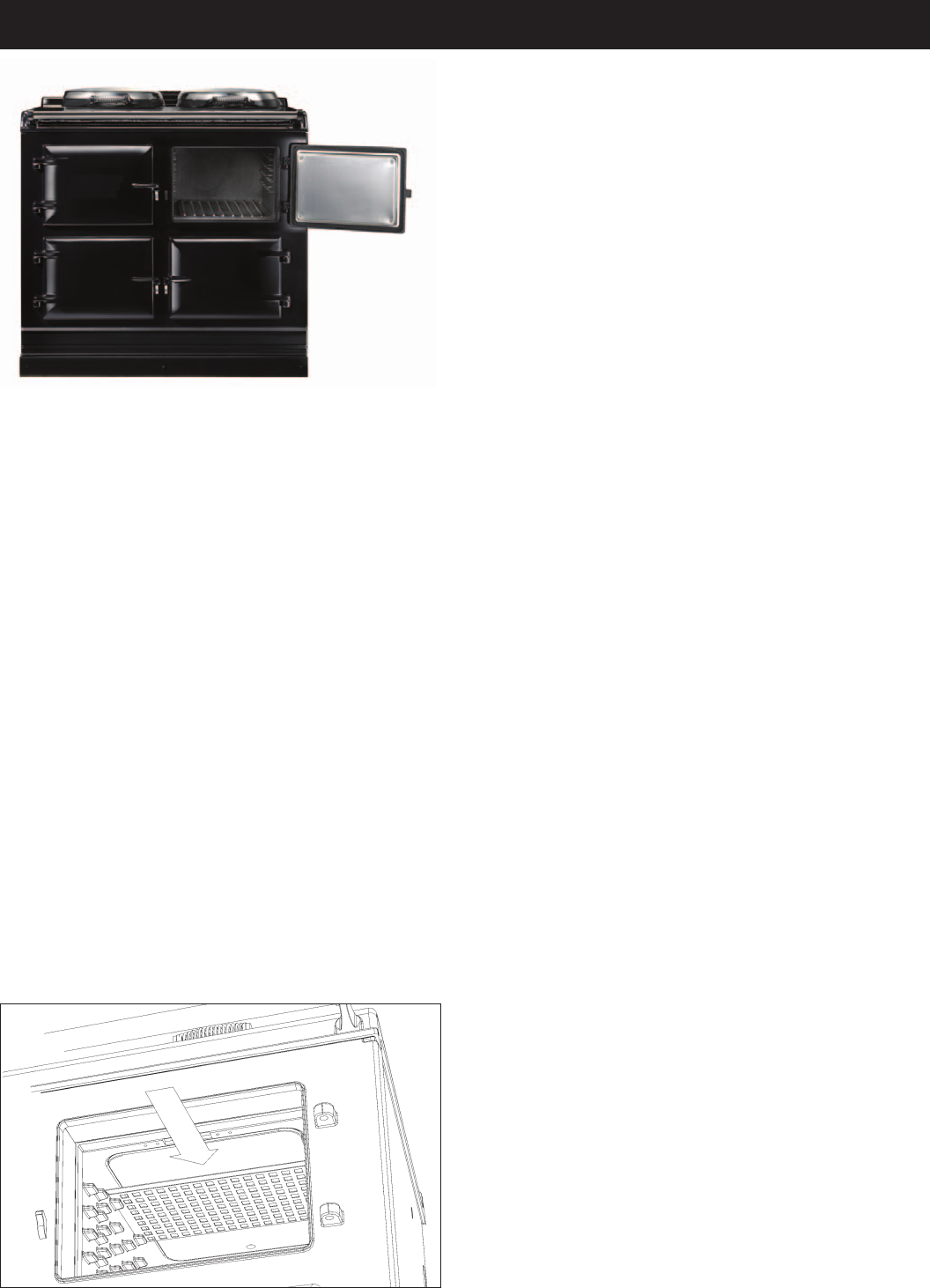
THE ROASTING OVEN
The roasting oven is indirectly heated by two elements, one in the
base of the oven and the other in the roof. These elements heat the
air and the cast iron within to provide cooking results consistent with
the classic AGA heat-storage cooker, with the flexibility of being able
to turn it to Slumber or Off when not required.
The roasting oven can be used for ‘broiling’ at the top and ‘shallow
frying’ on the oven floor.
• When cooking on the bottom of the roasting oven for long
periods of time (more than 30 minutes), place the floor grid
on the bottom of the oven before putting the food into the
oven, this lifts the food away from the base element to
ensure best cooking results are achieved.
A note when cooking on the bottom of the roasting oven……
• Please leave 1 hour before cooking directly on the bottom
of the oven, this is to ensure maximum temperature
stabilisation of the base element.
• You can cook directly on the bottom of the roasting oven for
short periods of time e.g. pizza, quiche, or foods that take
30 minutes or less.
NOTE: The roasting oven perforated baffle should be positioned in
the top of the roasting oven in order to optimise cooking
performance. It must be in place at all times, while the cooker is in
operation, including when grilling. (See diagram for fitment
of roasting oven perforated baffle).
The roasting oven is zoned in heat, meaning it is slightly hotter
towards the top than the center and the oven grid shelf set on the
oven floor is slightly less hot than the center.
The bottom of the oven can be used as another cooking surface,
indeed it is often called a hidden hotplate - for food needing longer
than 30 minutes, such as roast potatoes, on the bottom of the oven
you will need to use the floor grid for protection, so they do not over
brown.
The beauty of the roasting oven is that any fat splashes are burnt off
when the oven is at full heat, just brush out occasionally to get rid of
carbon deposits.
The roasting oven is excellent for bread and pastries. Quiches in
ceramic or pies in Pyrex dishes need not be baked blind as when
they are placed on the floor of the oven the pastry cooks from
underneath and the filling will set and brown from the all-round heat.
As you are aware metal flan pans conduct heat quicker than ceramic
so always place them on the floor grid placed on the bottom of the
oven to avoid over-base browning.
The specially designed roasting pans and bakeware slide directly
onto the runners, so almost every available square inch of space
can be used. Food can be protected by the use of the cold plain
shelf or shielded by means of the large roasting tin, which means
that you can cook food that requires different temperatures at the
same time. If food is browning too quickly and you do not want to
move it to another oven just slide the cold plain shelf over the food
to reduce the top heat.
Roasting Oven at Slumber
When the roasting oven is set at Slumber it can be used to
cook rich fruit cakes or slow cook roasts, casseroles and curries.
With the exception of meringues and rich fruit cakes, food that is to
be slow cooked should be brought up to heat before placing in an
oven at Slumber. The light will flash orange when heating up to
Slumber, then go solid orange when up to temperature.
For recipe ideas, see separate recipe book.
10 | The Full English
14 | Muffins
16 | Halloumi and Chargrilled Pepper Summer Salad
20 | Broccoli and Goat’s Cheese Tart
26 | Late Night Cheese on Toast
28 | Hearty Veg and Sausage Bake
36 | No Fuss Frittata
40 | Good Old Sunday Roast
42 | Roast Potatoes
42 | Roast Parsnips
43 | Yorkshire Puddings
46 | Stuffed Sea Bass with Roasted Mediterranean Veg
48 | Spatchcock Spring Chicken
50 | Moroccan Harissa Lamb and couscous
60 | Cherry and Almond Tart
72 | Homemade Burgers with Chunky Wedges
86 | AGA Loaf
90 | Classic Cream-Tea
92 | The Ultimate Roast Chicken
94 | Dad’s Favourite Steak and Ale Pie
96 | Winter Warming Fish Pie
20
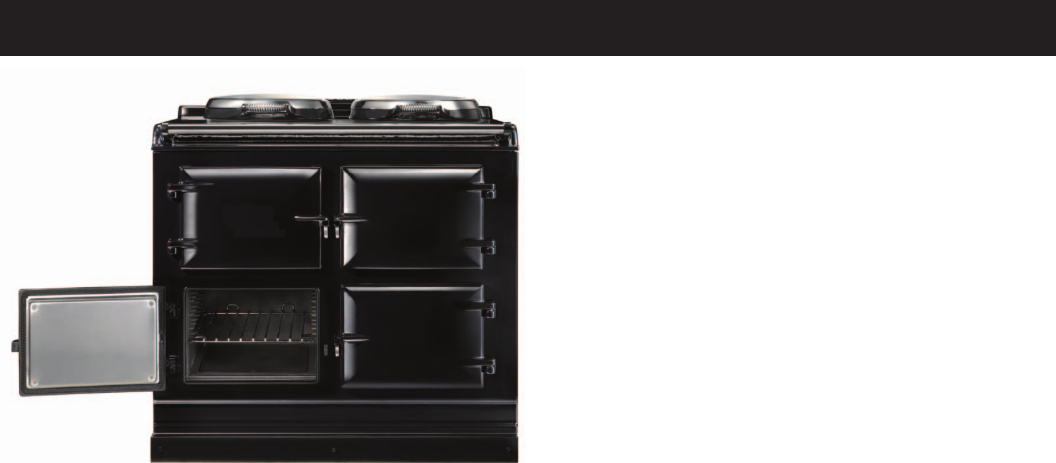
The baking oven is indirectly heated by two elements, one in the
base of the oven and the other in the roof. These elements heat the
air and the cast iron within to provide cooking results consistent with
classic AGA heat-storage cookers, with the flexibility of being able to
turn it to Slumber or Off when not required.
This oven is set at a moderate heat, so is ideal for cakes, biscuits;
also anything that requires medium heat cooking such as fish pie,
lasagne, soufflés, crumble and roulades. Meat and poultry can be
cooked here indeed most things that can be cooked in the roasting
oven can be cooked in the baking oven but for a longer time.
For the best results when cooking cakes do allow an hour heat
up time. Cook cakes together on one shelf if two shelves are used
interchange the food to achieve even coloration, as you would with
any oven which is zoned in heat.
As with the roasting oven the specially designed roasting pans and
bakeware slide directly onto the runners, so almost every available
square inch of space can be used. Food can be protected by
the use of the cold plain shelf or shielded by means of the large
roasting pan, which means that you can cook food that requires
different temperatures at the same time. If food is browning too
quickly and you do not want to move it to another oven just slide the
cold plain shelf over the food to reduce the top heat.
Baking Oven at Slumber
When the baking oven is set at Slumber it can be used to cook rich
fruit cakes or slow cook roasts, casseroles and curries.
With the exception of meringues and rich fruit cakes, food that is to
be slow cooked should be brought up to heat before placing in an
oven at Slumber. The light will flash orange when heating up to
Slumber, then go solid orange when up to temperature.
For recipe ideas, see separate recipe book.
14 | Muffins
52 | Cosy Night in with Venison and Bramble Sauce
53 | Potato Dauphinoise
56 | Dawn’s Damson Meringue Roulade
58 | Rhubarb and Ginger Crumble
64 | Fresh Raspberry and Chocolate Cheesecake
66 | Poppy Seed and Marmalade Traybake
73 | Potato Wedges
74 | Double Ginger Biscuits
76 | Cheeky Choc-a-lot Cupcakes
78 | Pumpkin Seed and Cranberry Flapjack
84 | The Victoria Sponge Cake
88 | Fruity Celebration Cake
THE BAKING OVEN
21
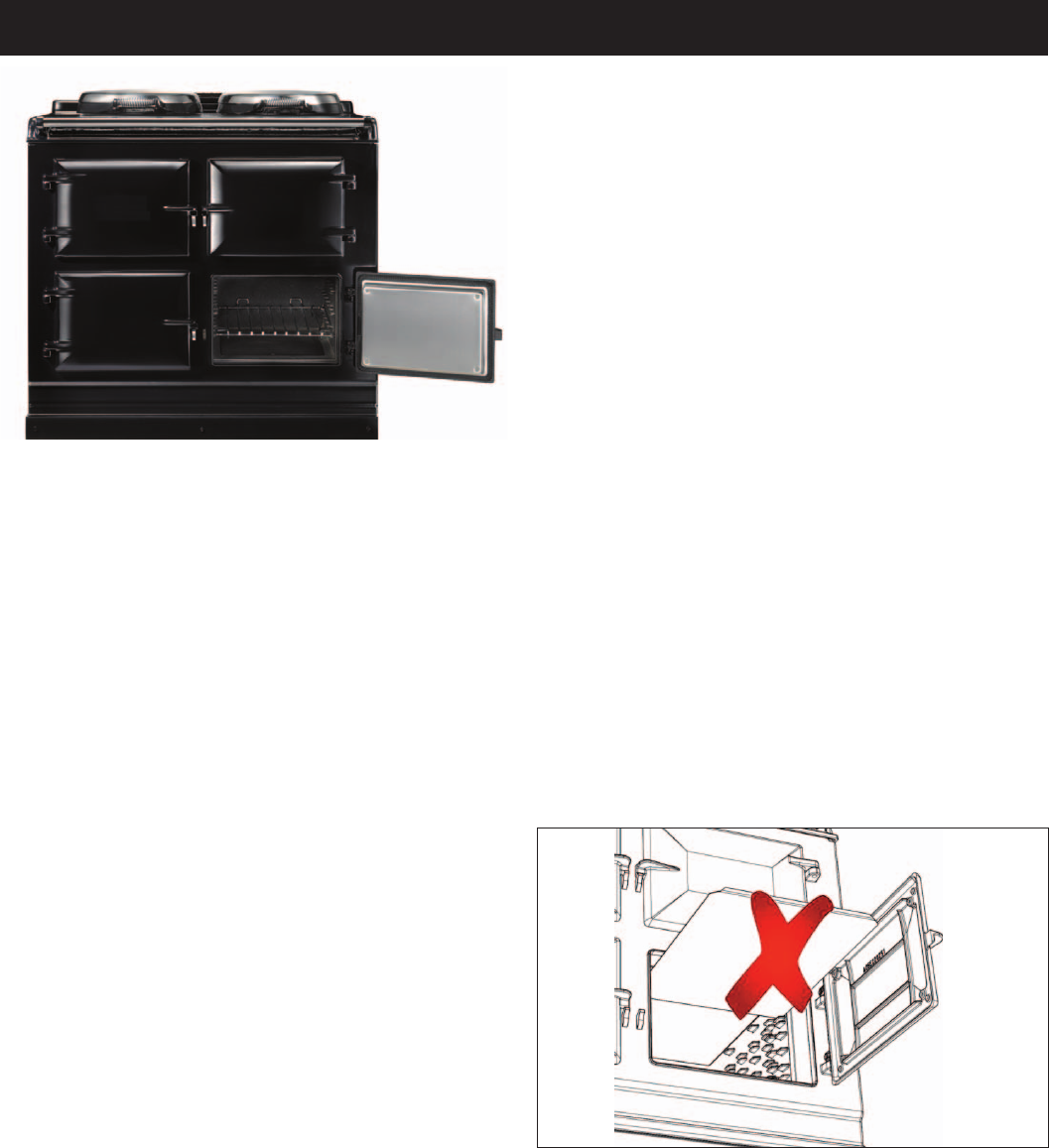
THE SLOW COOK OVEN
The slow cook oven is indirectly heated by one element in the base
of the oven.
This element heats the air and the cast iron within to provide cooking
results consistent with the traditional slow cook oven
of the classic AGA heat-storage cooker, with the flexibility of being
able to turn it to Off when not required. The slow cook oven is
always at a simmer or Slumber mode ideal for long slow cooking.
The floor grid is used here to protect items placed on the bottom
of the oven such as vegetables for steaming, keeping sauces warm
or casseroles cooked for a long time. Always ensure this
is in place, before putting food into the oven.
The slow cook oven can be described as a continuation oven, it
continues to cook food that has been brought up to heat elsewhere
on the cooker with the exception of meringues which are dried out
rather than ‘cooked’. Therefore the following recipes call for heating
the food on the hotplates or in the roasting oven before placing in
the slow cook oven,
For recipe ideas, see separate recipe book.
06 | AGA Porridge
32 | Quick and Easy Mushroom Risotto
38 | Chilli Con Carne
42 | Steamed Carrots
50 | Moroccan Harissa Lamb and couscous
54 | Marcia’s Slow Cooked Pork and Butternut Squash
Casserole
62 | Pears with Cardamom
68 | Steamed Banana Pudding drizzled in Butterscotch
Sauce
94 | Dad’s Favourite Steak and Ale Pie
User Guidance
• Allow the oven to heat up fully, the longer the oven is on the
better, since this helps reduce the amount of moisture created
during slow cooking.
• To get the very best performance, we recommend to use AGA
cookware with thick bases and stacking lids.
• Do not place dishes directly on to the oven base. Always place
onto either a shelf or the floor grid.
• Cuts of meat and poultry should be brought up to heat ideally in
the Roasting oven for 30 - 45 minutes, then transfer to the
Slow Cook oven.
• This method is unsuitable for stuffed meat and poultry.
• Make sure that pork and poultry reach an internal temperature of
at least 167°F.
• Always bring soups, casseroles and liquids to the boil on the
hotplate before putting in the oven.
• Always thaw frozen food completely before cooking.
• Root vegetables will cook better if cut into small pieces.
• Adjust seasonings and thickenings at the end of the cooking
time.
• Many dried beans for example, dried red kidney beans must be
boiled for a minimum of 10 minutes, after soaking, and before
inclusion in any dish.
PLEASE NOTE: DO NOT store anything in the Slow Cook oven and
DO NOT use any large cookware such as the cold plain shelf until
the oven has reached its operating temperature. Failure to do this
may cause the safety function to lock the appliance in the OFF
position. It is also advisable when using large cookware in the
Slow Cook oven to push it to the back of the oven.
22

AGA TC5 (HOTCUPBOARD OPTION)
Slow Cooking Oven plus Warming Oven
These ovens are heated by a single element at the rear of the oven
cavity. It is operated by a single push ON-OFF button located on the
left hand side of the hotcupboard top plate and can be turned ON
and OFF when required.
Slow Cooking Oven
This oven has similar characteristics of the simmering oven and
should be utilised in a similar manner. It delivers a gentler convected
heat making it better suited for longer cooking times especially for
overnight cooking, for example rich fruit cakes and celebration
cakes. The cooking of meringues may also be better suited for this
oven.
NOTE: These ovens vent into the room, mechanical venting to the
outside is not available.
Points to remember when Slow Cooking:
• Pre-heat the oven for 30 minutes before starting to cook.
• Bring casseroles, soups etc to the boil on the hob and meats
started in the roasting oven, before placing in the slow cooking
oven.
• Make sure that casseroles have sufficient liquid, particularly when
cooking over a long period.
• Use lids on casseroles or foil to cover food whilst it is cooking to
retain moisture.
• Make sure all dishes will fit into the oven before preparing food.
• Wrap washed and pricked jacket potatoes in foil before cooking.
• Make sure that meat and poultry is piping hot before eating.
• Always thaw frozen food completely before cooking.
You can also produce crisp, white meringues cooked in the slow
cooking oven.
Timings for cooking in the slow cooking oven will depend upon the
temperature, quantity and type of dish you are cooking, as a guide
for casseroles, a minimum of 3 hours cooking time is recommended.
Keep an eye on the food until you are familiar with the oven.
23

CLEANING AND CARING
IMPORTANT INSTRUCTION
BE CAREFUL OF THE HOT APPLIANCE.
DO NOT USE A STEAM CLEANER TO CLEAN
THIS COOKER.
DO NOT USE ABRASIVE PADS, CAUSTIC
CLEANERS, OVEN CLEANERS OR METAL
SCRAPERS TO CLEAN THE SURFACES OF THE
ENAMEL.
THE TOUCH CONTROL PANEL MAY BE CLEANED
WITH A DAMP CLOTH AND WARM SOAPY WATER.
DO NOT USE ANY POWER SPRAYS OR OVEN
CLEANERS ON THE CONTROL PANEL.
Top Plate and Front Plate
The easiest way to clean the AGA top plate and front plate is to mop
up spills as soon as they happen. It maybe useful to keep a damp
cloth handy to do this. Baked-on food is more difficult to clean but
can usually be removed with vitreous enamel cleaner or mild cream
cleaners using a damp cloth, or, if necessary a nylon scouring pad. If
milk or fruit juice or anything containing acid, is spilt on the cooker,
wipe it up immediately. Also clean off any condensation streaks on
the front plate around the oven doors or the vitreous enamel maybe
permanently discolored.
All that is usually needed to keep the vitreous enamel surfaces of the
cooker bright and clean is a daily rub over with a damp soapy cloth
followed immediately with a clean, dry cloth to avoid streaks. The
AGA E-cloths are excellent for this.
Remember the top plate and the polished covers will scratch if pans
or utensils are dragged across them.
Insulating Covers and Oven Door Linings
The best way to keep the linings clean is to wipe them over after
cooking so that splashes do not get baked on (being careful with a hot
cooker). Clean the linings when they are cool, the cooker is off.
Linings of the Insulated Covers (lid interior) - the use of an AGA
splash shield is recommended to keep the lining free of fat splashes
(obtainable from your AGA Retailer). If the linings are marked these
are best cleaned when the hotplates are cold. Linings can be cleaned
with hot soapy water and /or a cream cleanser. If badly marked then
a soapy soap-impregnated pad can be employed - this should be
used in a circular motion. The first few times you use a soap-
impregnated pad you will see the circular marks but these are
reduced and the surface of the linings become shinier each time of
use. Do not use excessive water and make sure the linings are dry
before closing the covers.
Oven door linings - the linings can be cleaned with hot soapy water
and / or a cream cleanser. To deep clean the linings, place a towel on
the work surface and carefully lift off the oven door (doors are heavy)
and place it enamel side down on the towel padding. Clean with a
soapy impregnated pad to remove stubborn marks. Do not immerse
the doors in water as they are packed with insulating material which
will be damaged by excessive moisture. Needless to say, do not put
oven doors in a dishwasher! Dry off before carefully replacing on
their hinges.
Insulating Covers and Oven Door Linings
The tops of the insulating covers (lids) these are stainless steel and
can be kept clean by wiping over with a damp cloth and polished up -
the AGA E-cloths are excellent for this purpose as they are lint free
and eco-friendly. AGA Stainless Steel and Chrome Cleaner are
recommended to keep the insulated covers clean and shining, which
can be purchased from your AGA Specialist. To clean the oven doors,
ensure the ovens are turned off and allowed to cool before cleaning.
They may be cleaned with a cream cleaner or soap impregnated pad.
To clean the insulating covers, ensure the hotplates are turned off
and allowed to cool before cleaning. They may be cleaned with a
cream cleaner or soap impregnated pad.
DO NOT IMMERSE THE DOORS IN WATER AS THEY ARE
PACKED WITH INSULATING MATERIAL WHICH WILL BE
DAMAGED BY EXCESSIVE MOISTURE.
DO NOT PUT OVEN DOORS IN A DISHWASHER.
Ovens
The cast iron ovens help to keep themselves clean, they merely need
to be brushed out occasionally with the wire brush supplied.
The ovens are made from cast iron, and are very durable, but they
will rust if surface moisture is left on them regularly. Remember to
always switch the ovens on, to dry them out after cleaning. This is
done by leaving them to heat up until the green light on the control
panel turns solid.
Heating up of the ovens periodically, will help burn off any cooking
deposits to aid cleaning within the ovens.
Hotplates
The hotplates are easy to care for, and regular maintenance will ensure
long-life. Should the hotplates become soiled, use a sponge, cloth,
scouring pad or wire brush to remove burnt-on spills. Rinse off
detergents or cleaning agents thoroughly. Hotplates are made from cast
iron, and are very durable, but they will rust if surface moisture is left on
them regularly. Remember to switch on the plates for a few minutes to
dry them after cleaning. Every now and then, apply a thin coating of
cooking oil when the hotplates are cold.
Roasting Pans
The enamelled roasting pans supplied with the AGA Total Control
should be cleaned in hot soapy water, soaking if necessary. A nylon
scouring pad can also be used. They may also be cleaned in the
dishwasher, but with constant use, the enamelled finish will become
dull in appearance.
DO NOT use caustic cleaners or oven cleaners.
PLEASE NOTE: Cleaners used for Vitreous Enamel are
often unsuitable for use on: chrome and stainless steel
components, including the insulating covers, hand-rails
and their brackets.
24
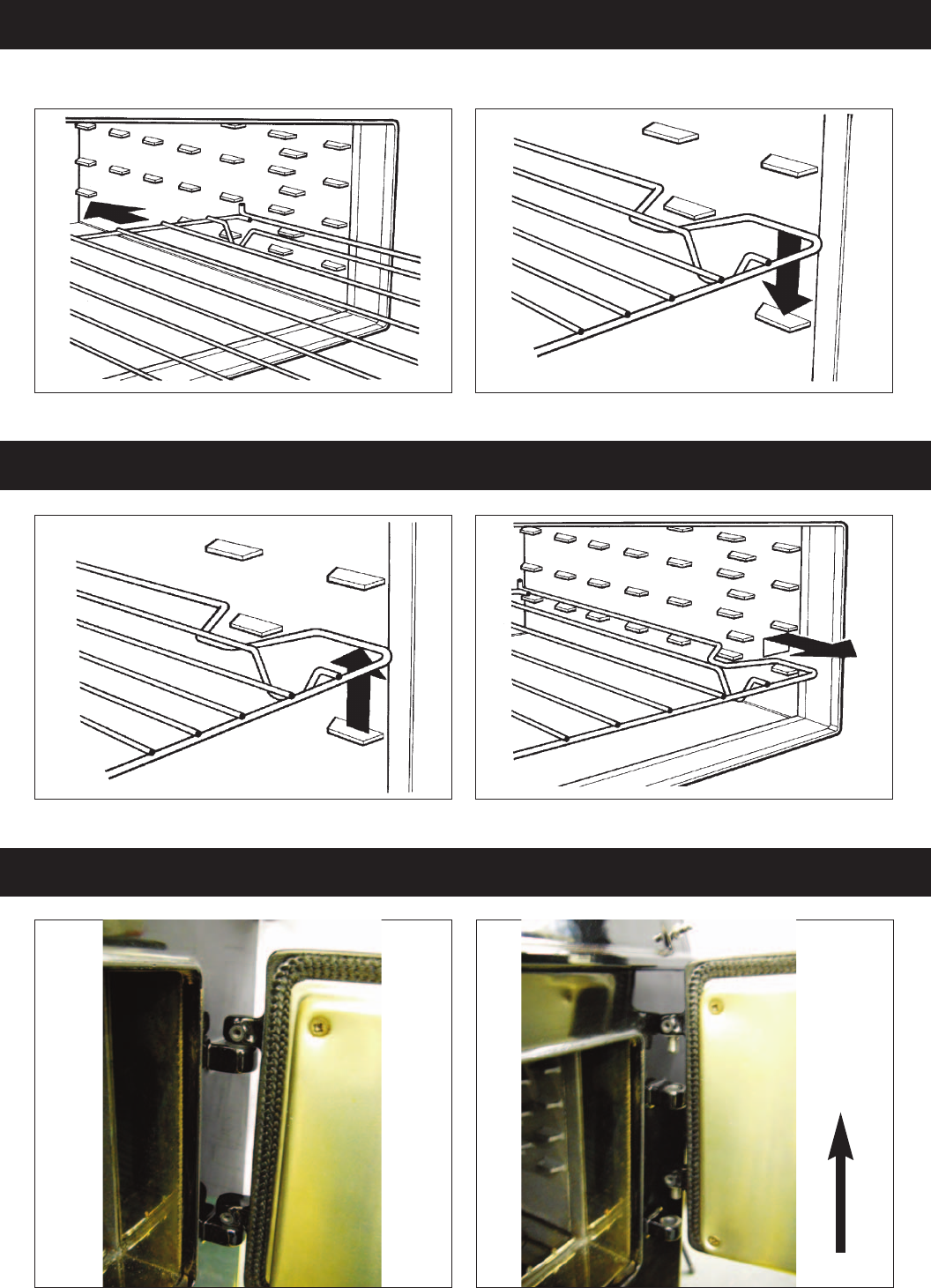
When using the oven shelves for the first time follow Figs. 4 - 7.
fig 4 fig 5
fig 6 fig 7
FITTING OF OVEN SHELVES
REMOVAL OF OVEN SHELVES
25
FITTING AND REMOVAL OF OVEN DOORS
fig 8 fig 9
DOOR HINGES LOCATED ENSURE DOOR IS OPEN BEFORE LIFTING UP
AND OFF TO AVOID DAMAGE TO THE
ENAMEL
LIFT UP
AND OFF

SERVICE
• In the event of your appliance requiring maintenance, please
contact AGA Marvel or your AGA Retailer.
• Your cooker must only be serviced by a qualified engineer,
from an authorized AGA Specialist.
• Do not alter or modify the cooker.
• Only the parts specified by the manufacturer, are to be
fitted.
• The appliance warranty does not cover Commercial use.
For continued efficient and safe operation of this appliance, it is
important that servicing is carried out at regular intervals as
recommended by your AGA Retailer. The cooker should be turned
OFF in advance of the service so that the appliance will have cooled
down sufficiently.
A HOT APPLIANCE CANNOT BE SERVICED.
26
WARRANTY
WELCOME
Thank you for choosing an AGA cooker. We are sure that you will be impressed with the performance of your new AGA cooker and with the
ongoing service you will receive.
PEACE OF MIND
Every new AGA leaving the factory and installed by an AGA approved outlet carries a 5 year guarantee on parts (certain consumable parts are
excluded - for full details see below). This also includes all labor charges for the first 12 months.
DISTRIBUTION AND SERVICE NETWORK
AGA has set up an International Distributor and service network with fully trained service engineers available to support your AGA within the
guarantee period. The approved outlet installing your AGA is responsible for providing this warranty.
No charge will be made for replacement parts providing:
• An appliance fault is found.
• The relevant part of the AGA is still covered by the guarantee.
• Regular servicing has been carried out in accordance with the manufacturer’s instructions by authorized AGA engineers, using approved
spare parts. The service booklet will need to be completed accordingly.
There will be no labor charges during the first 12 months of the warranty.
A call out charge may be applicable if:
• The authorized AGA service engineer who calls at your home finds no fault with the AGA.
• Other parts of your plumbing system or flue, are either faulty or do not comply with the appropriate installation instructions.
• The unit is more than 12 months old.
• If it is deemed the product has been misused.
Please note that invoices for call out repair work carried out during the guarantee period by any third party cannot be accepted.
In the event of an appliance fault during the guarantee period, please contact your service provider. They will arrange for an engineer to call as
soon as possible.
What is not included in the guarantee
• Consumable parts
• Flues (except integral power and balanced flues).
• Any labor charges not directly connected with the repair or replacement of a faulty component.
• Any consequential loss.
• Any part of the domestic hot water system which is not an integral part of the AGA.
• Accidental or cosmetic damage.
• Routine preventative service and maintenance.
• Any external controls/components not supplied by AGA.
• Oil filled Heat indicators are only covered for 12 months.
REGULAR SERVICING
Regular maintenance is an essential part of keeping your AGA cooker running safely and efficiently.
Since your AGA can operate continuously it is important to ensure regular servicing is undertaken by AGA Service or your Authorized AGA
Distributor. Only genuine AGA spare parts are used.
Please note that routine servicing in accordance with the manufacturer’s instructions is also a condition of the warranty agreement.
To ensure your AGA receives this essential maintenance, please contact AGA Service or your Distributor, who will be pleased to help.
Service Intervals
(Certain models may vary)
Oil AGA - every 6 months
Gas and Electric Heat Storage AGA’s - every 12 months
Electric 13 amp and AGA Total Control - Interim service 2 1/2years (30 months)
Full service 5 years (60 months)
CONSUMABLE PARTS NOT COVERED BY THIS WARRANTY
Oil AGA - oil filters and wicks
Gas Fired AGA’s - ignitor electrodes, thermocouples
Electric AGA - Vent and circulation fans are for 2 1/2years (30 months)
EXCLUSIONS
This warranty does not cover products which have been altered by the customer or by a third party. Materials, spare parts and specific tools
must be as recommended by AGA.
Warranty does not cover misuse, abuse or impact damage. Corrosion caused by incorrect use of chemical cleaners or scratches to chrome
or stainless steel components by abrasive cleaning materials are also excluded.
Warranty strictly excludes commercial use. Appliances are covered for domestic use only.
Flues and Ventilation and External Services:
External services, gas supply, external oil lines, tanks and filters are not covered under this warranty.
This warranty does not cover incorrectly or poorly maintained flue systems or appliances installed on incorrect flue systems of unsuitable
material and outside the specification detailed in the product instructions.
Appliances not provided with adequate ventilation as detailed in the product instructions also fall outside this warranty.
This policy applies to products which carry the AGA name plate and trademark
(AGA utensils and accessories are covered by a separate policy)
Product fuel conversions are not covered
THIS WARRANTY POLICY DOES NOT AFFECT THE OWNERS STATUTORY RIGHTS
27
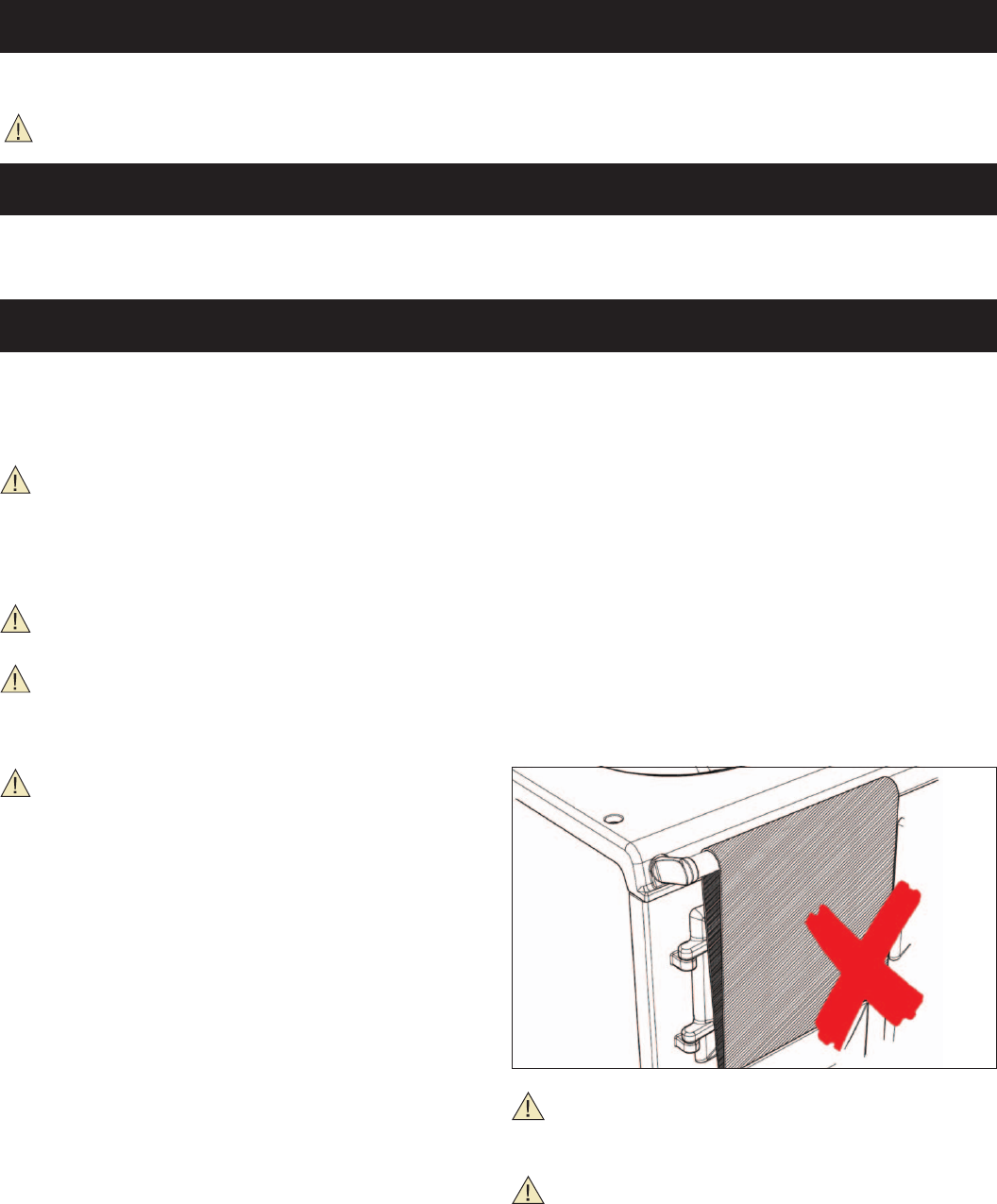
28
Consumer Protection
As a responsible manufacturer, we take care to make sure
that our products are designed and constructed to meet the required
safety standards when properly installed and used.
This appliance is not intended for use by persons
(including children) with reduced physical, sensory or
mental capabilities, or lack of experience and
knowledge, unless they have been given supervision
or instruction concerning use of the appliance by a
person responsible for their safety.
Children should be supervised to ensure that they do
not play with the appliance.
PLEASE READ THE ACCOMPANYING WARRANTY
Any alteration that is not approved by AGA could
invalidate the approval of the appliance, operation of
the warranty and could also affect your statutory rights.
APPLIANCE
YOUNG CHILDREN SHOULD BE KEPT AWAY FROM
THE APPLIANCE AS SURFACES CAN BECOME HOT
TO TOUCH.
Deep Fat Frying
• Use a deep pan.
• Never fill the pan more than one-third full of fat or oil.
• Never use a lid on the pan.
• Important: Oil is a fire risk, do not leave pans
containing oil unattended.
• In the event of a fire, cover the pan with a lid and turn OFF
the appliance.
Smother the flames on the hob preferably with a fire blanket,
rather than attempting to remove the pan to the outside.
Burns and injuries are caused almost invariably by picking up the
burning pan to carry it outside.
• Do not hang clothes on the left hand side of the AGA
hand-rail. The electrical controls are behind the top left hand
door, blocking the air vent can cause excessive control
temperatures, and will prevent easy access to the controls.
When the oven(s) are on DO NOT leave any oven door
open for long periods, this will effect the temperature of
the oven and may allow controls to become hot.
A little smoke and some odor may be emitted when the
appliance is first switched on. This is normal and harmless
(from oven lagging and starch binder on the element insulation)
and will cease after a short period of use.
HEALTH AND SAFETY
ERROR CODES
In the unlikely event an error occurs with your AGA Total Control cooker,
error codes may be displayed on your handset, for example:
3.11
Please provide AGA Service with this information. It will assist the
service engineer with diagnosing your fault.
SERIAL NUMBER
Make a note of your AGA Total Control Serial Number when it is
being installed. The serial number can be found behind the magnetic
plinth cover.

AGA BASIC RECIPES
These are some fundamental recipes and methods to complement your first AGA cooking ventures. The real basics to get you started and used
to using your AGA Total Control cooker. Relax, enjoy and then try some of our ideas in the Recipe section of this handbook.
AGA Toast
AGA toast is renowned for its excellence, crisp on the outside and
soft in the center. Take thick slices of bread and place in the AGA
toaster – if the bread is very moist or very fresh, heat the toaster
beforehand to prevent sticking – lift the boiling plate insulated cover
and place the toaster direct onto the plate with the handle at an
angle from the handle of the cover. Close the cover and wait for the
bread to toast one side – this will take 1-2 minutes dependent upon
the variety of bread – open the cover and turn the toaster over and
repeat the process to toast the other side.
Serve piping hot with butter and marmalade. A great start to
the day!
Steaming Vegetables
Steaming of root vegetables can take place either on the hotplates
using a steamer over an AGA saucepan, alternatively if you have the
slow cook oven, (or any oven at Slumber), switched on then you can
oven steam the root vegetables. Oven steaming means saucepans
of root vegetables can be started on the hotplates, using a small
amount of water, brought to the boil for 3-5 minutes, the water
drained and the saucepan lid replaced. Put on the floor grid in the
simmering oven for 20 -30 minutes until tender. 6-8 saucepans can
be accommodated in the slow cook oven, leaving the hotplates free
for 6 more!
Green vegetables benefit from quick boiling on the boiling plate to
keep their vibrant colour, or you can steam them over boiling water.
Quick White Sauce
This is a coating sauce and can be used in a pasta bake, on its own
or flavoured to accompany vegetables. For a pouring sauce reduce
the quantities of butter and flour to 11/2oz retaining the same amount
of milk.
Makes (1 pint)
2 oz butter
2 oz plain flour
3/4 pint milk
Salt and white pepper
Place all the ingredients into a saucepan.
AGA hotplate cooking: Place on the simmering plate and use a
silicone whisk to whisk continuously until the sauce has come to the
boil and thickened. Cook for 2 minutes, still whisking, check the
seasoning and use as required – for example over broad beans,
steamed baby beetroot, Jerusalem artichokes.
Variations
Cheese sauce
Whisk in 1 tsp mustard and 2 oz well-flavoured cheese.
Parsley sauce
Whisk in 3 tbsp chopped parsley, serve at once with cooked
ham or fish.
Béchamel sauce
Before making the sauce infuse the milk to flavor it with a quartered,
peeled onion and a bay leaf, discard these and continue as above.
Boiling a kettle
When the boiling plate is switched on then it’s time for tea!
The AGA kettles are especially designed for maximum performance
on your cast iron hotplates, the kettle will boil quickly on the hot
boiling plate - if you have just turned on the boiling plate obviously it
will take longer to boil! Always use fresh water, just enough in the
kettle for your requirements and it’s a good habit to always leave the
kettle empty to minimise the build up of limescale.
Place the kettle onto the boiling plate, giving it a slight twist as you
do so to ensure a perfect contact. Also check the hotplates are clear
of any burnt on spills or crumbs - just brush over the cast iron with
the wire brush, supplied with your new AGA Total Control. Pointing
the spout towards the lid lining will help keep it clean, as the steam
can loosen splashes. Give the lining a quick wipe over after removing
the kettle.
29
30
31

For further advice or information contact
your local AGA Specialist
With AGA’s policy of continuous product
improvement, the Company reserves the right to
change specifications and make modifications to
the appliance described and illustrated at any time
US Office:
AGA MARVEL
1260 E Van Deinse St.
Greenville, MI 48838
www.agamarvel.com
32